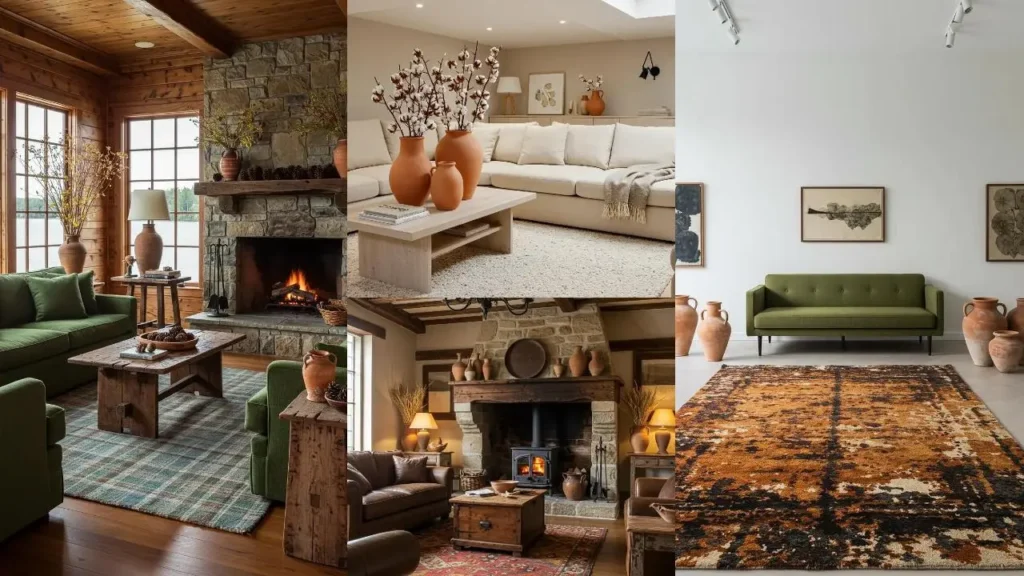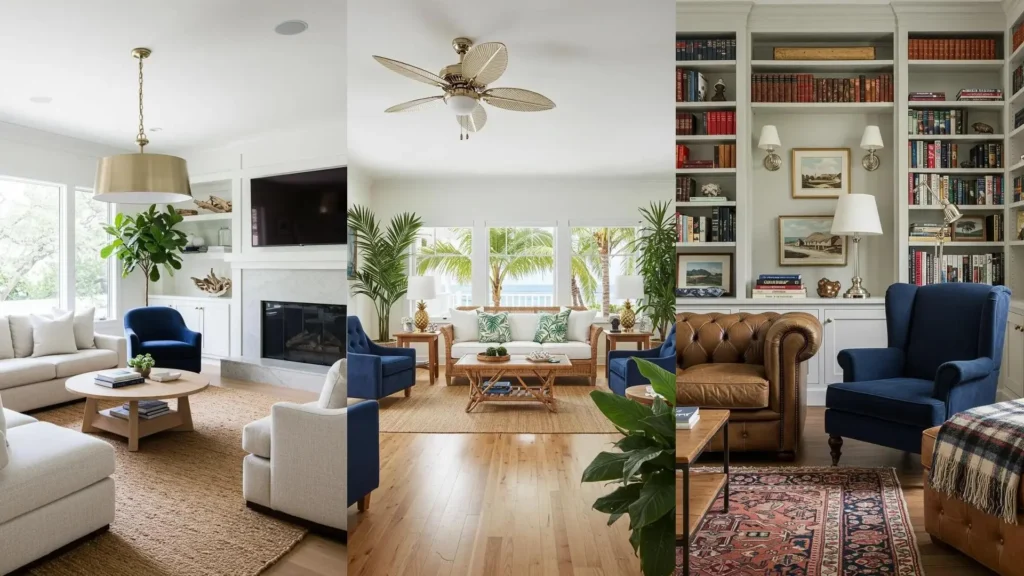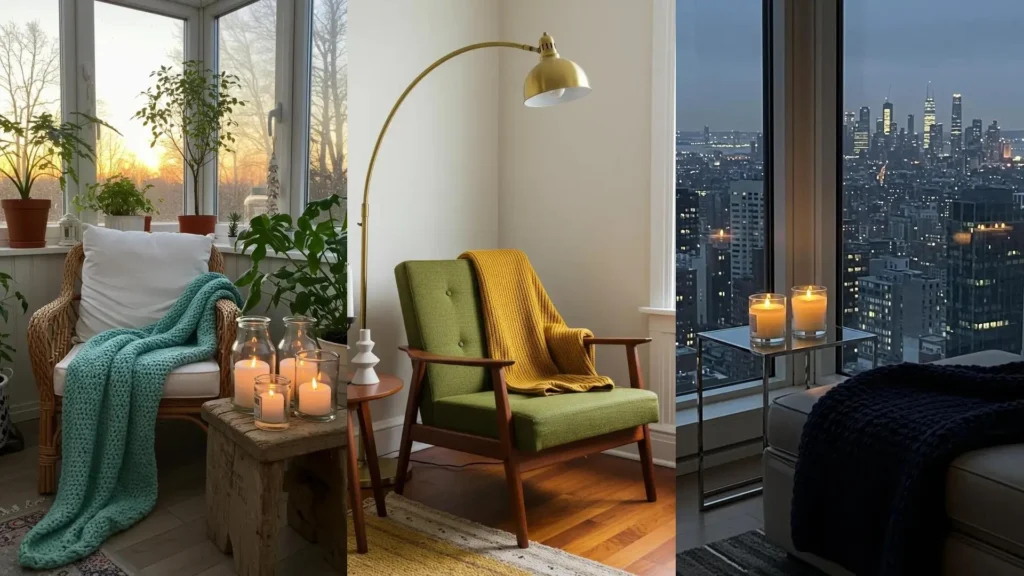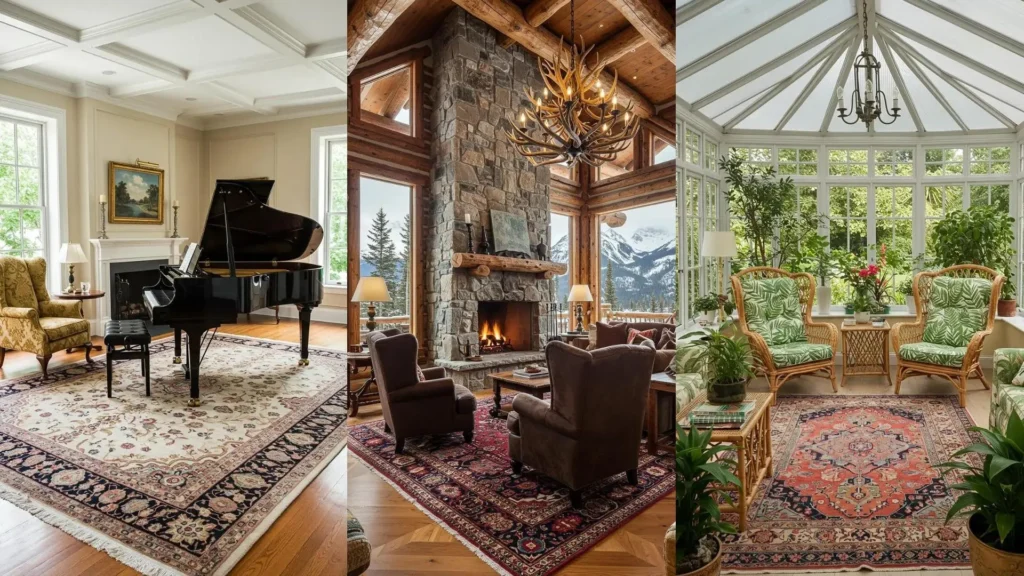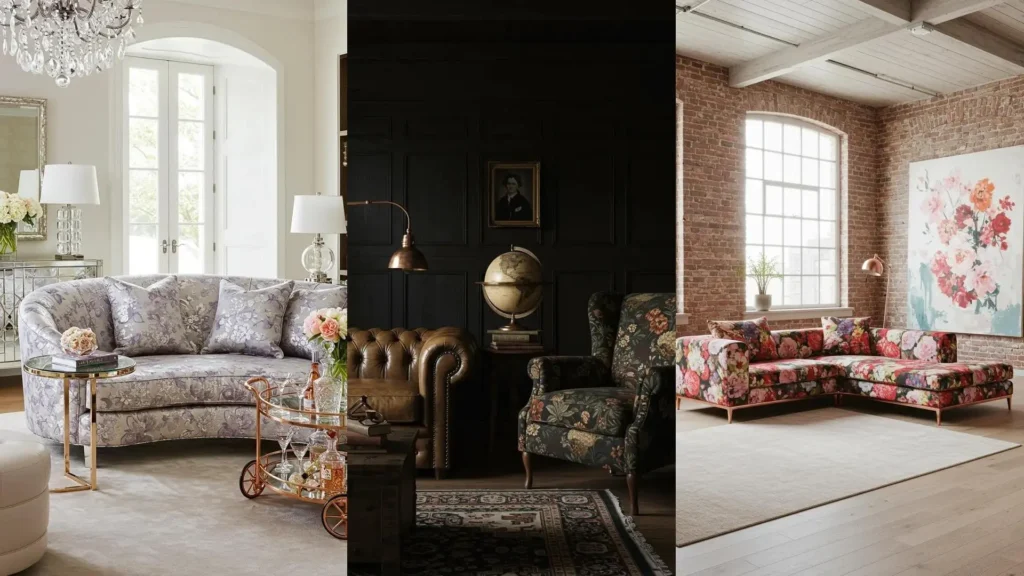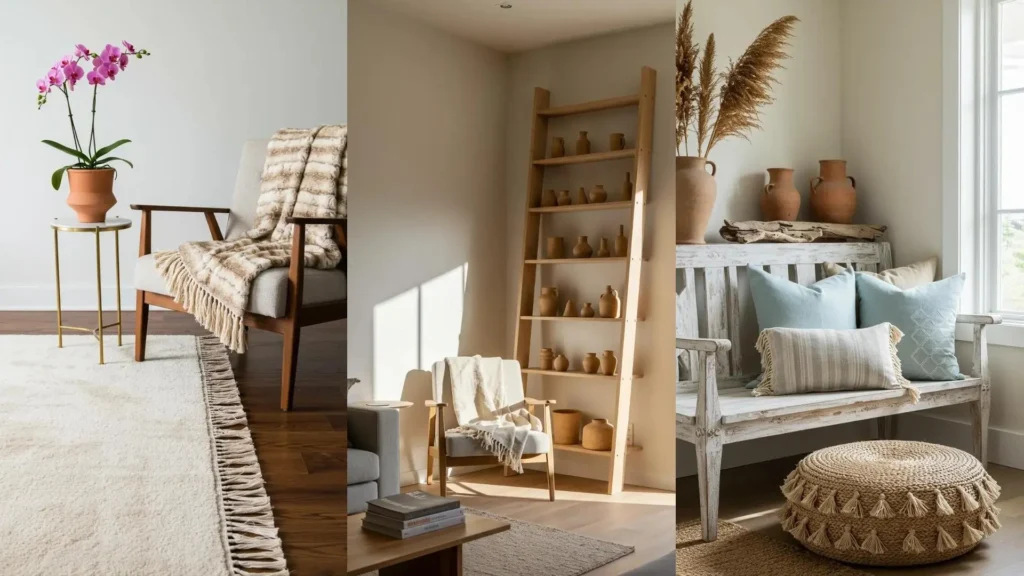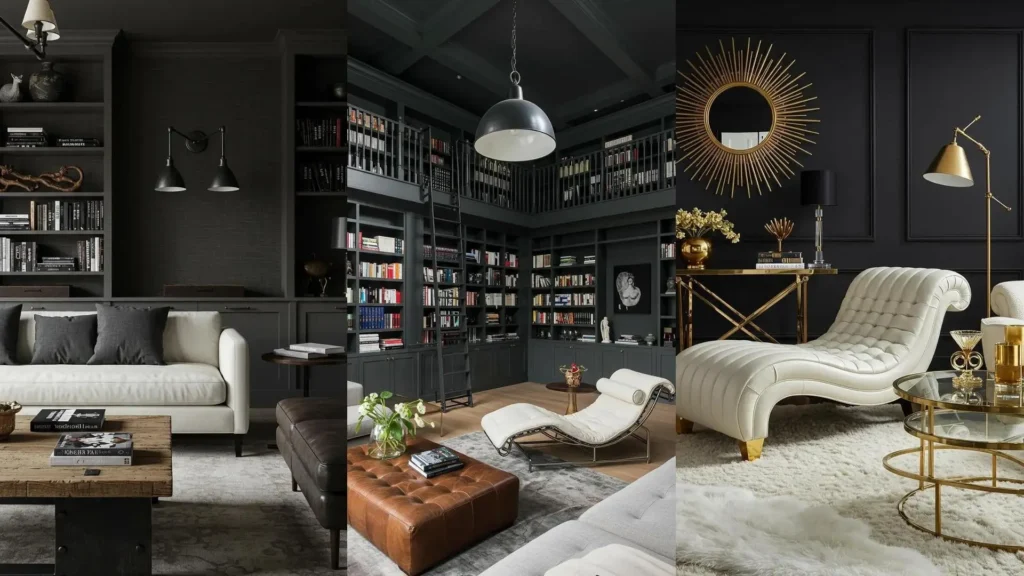Does your living room feel almost there, yet somehow still a step away from truly reflecting you?
You’re not alone in seeking that elusive balance – a space that feels curated, not chaotic, and offers both beauty and everyday ease.
The good news is, achieving this sophistication doesn’t demand a complete overhaul.
Often, it’s about understanding the subtle interplay of textures, the strategic placement of light, and the quiet power of natural materials.
Today, we’ll explore how specific, actionable adjustments – from the grounding presence of a handwoven wool rug to the elegant warmth of terracotta vases – can transform your living room into a polished, inviting sanctuary.
Let’s uncover the precise details that make all the difference, immediately.
1. Elevating Lofty Spaces with Natural Textures

When faced with grand proportions and abundant natural light, resist the urge to fill every void.
Instead, focus on grounding the space with a generously sized area rug that introduces a tactile warmth underfoot.
For height, leverage the verticality of your windows by incorporating tall, graceful natural elements like pampas grass or architectural branches in oversized terracotta vessels.
Varying the heights and forms of these vases on your coffee table or console creates a dynamic yet understated visual interest.
Select accent pillows in earthy tones like burnt orange and deep olive to tie the color story together without overwhelming the airy feel.
2. Mediterranean Serenity Through Arches and Artisanal Forms
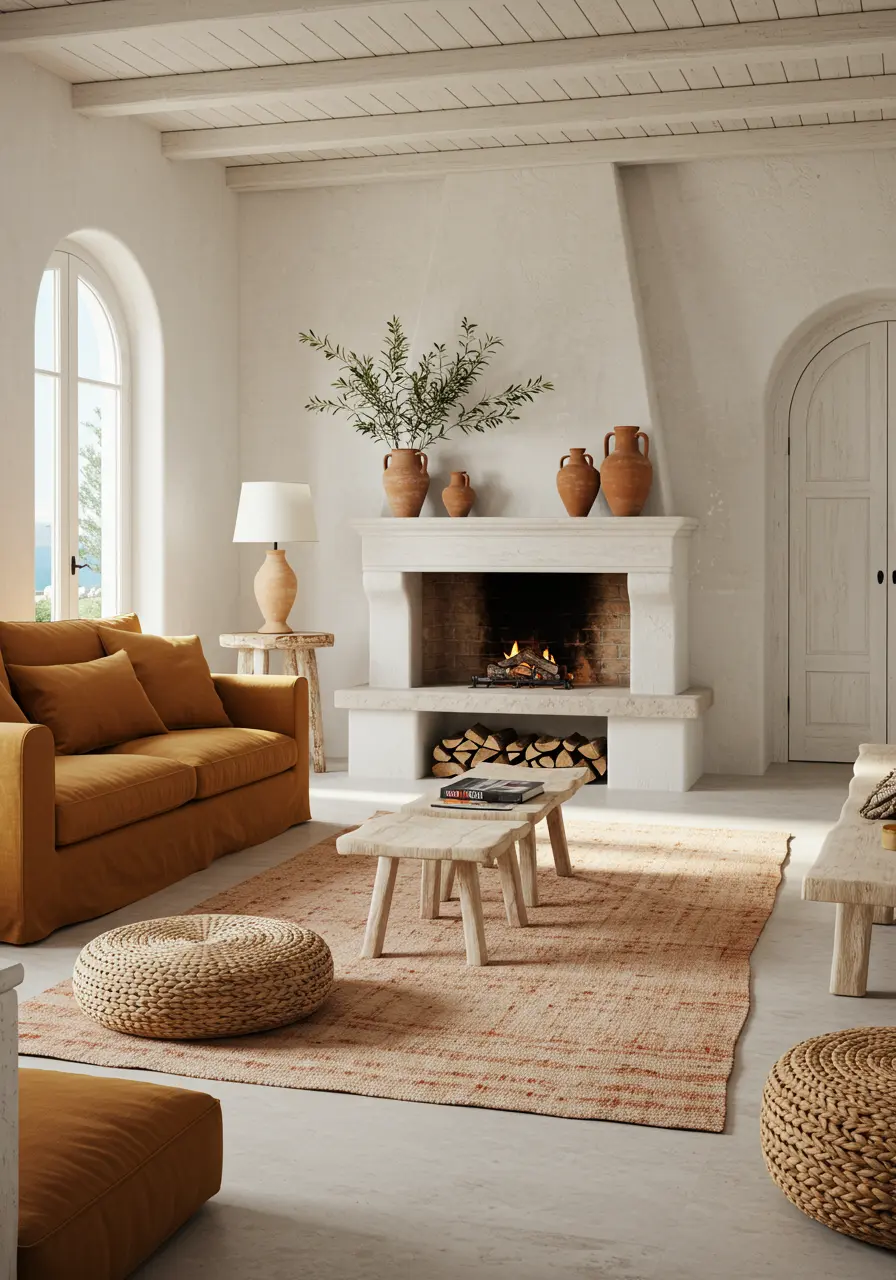
Create a sense of Mediterranean tranquility by softening sharp lines with gentle arches, whether through architectural elements or cleverly placed mirrors and furniture.
Build a quiet foundation with plaster-like wall finishes that diffuse light beautifully, complementing your chosen earthy tones.
For your fireplace, style the mantel with an asymmetrical cluster of terracotta vases of varying sizes and shapes to introduce an organic, handcrafted feel.
Ground the seating area with a finely woven jute rug, layering in a low, comfortable woven pouf to invite casual relaxation.
This thoughtful layering of textures ensures depth and warmth without the need for excessive color.
3. Curated Warmth in a Historic Setting

In spaces rich with architectural character like exposed beams and stone fireplaces, your furniture and decor should complement, not compete.
A deeply hued, intricately patterned wool rug becomes the anchor, unifying the room’s diverse elements while adding a foundational layer of warmth.
Introduce robust leather seating that patinas beautifully over time, telling a story of comfort and longevity.
On your mantelpiece, arrange a collection of artisanal terracotta pots, varying their heights and forms to create a naturally evolving display.
Supplement overhead lighting with multiple warm lamps to cast inviting pools of light, enhancing the room’s cozy, lived-in appeal.
4. The Art of Subtlety: Sheer Drapes and Textured Walls
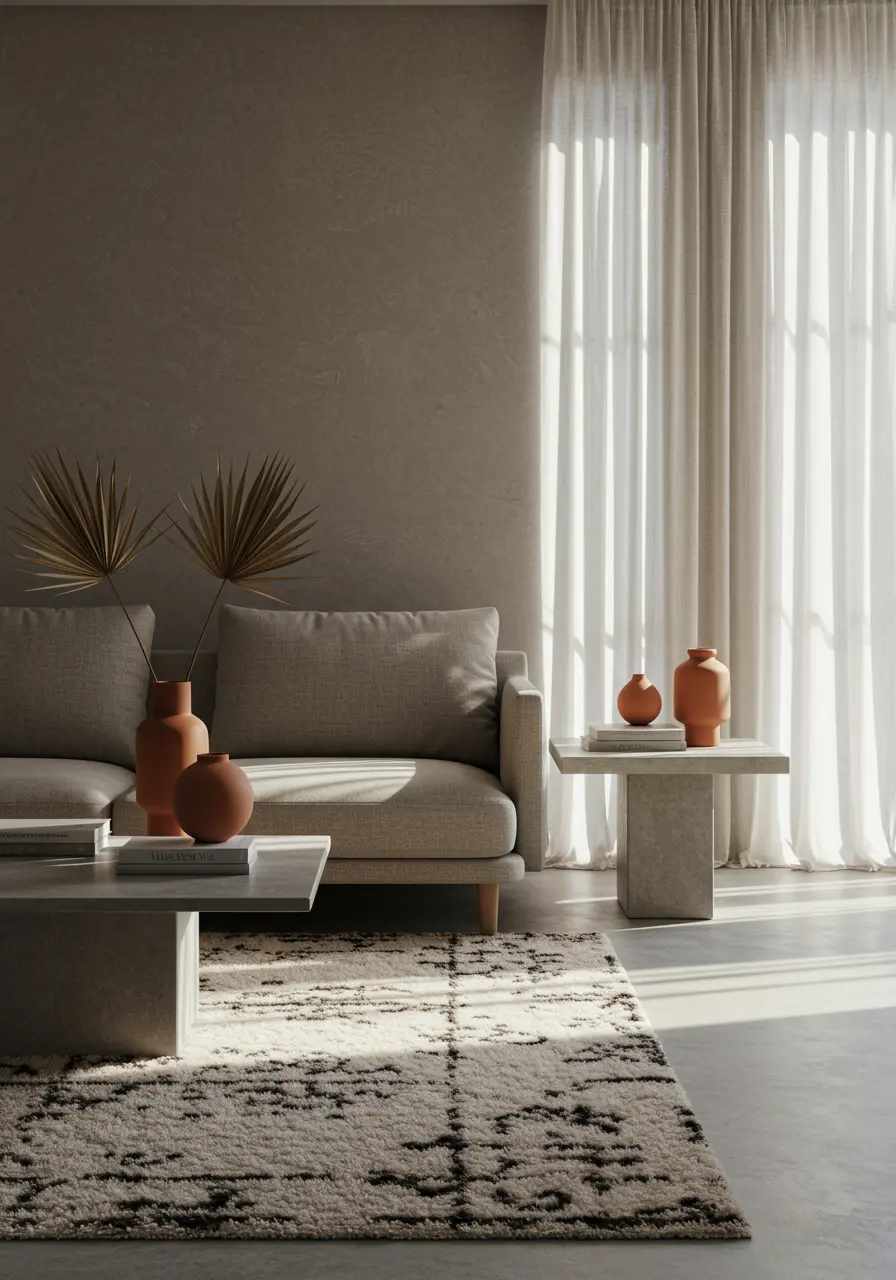
To achieve a sophisticated sense of calm, consider a monochromatic palette elevated by rich textures.
Floor-to-ceiling sheer drapes, for instance, not only frame your windows beautifully but also filter natural light, creating a soft, ethereal glow without sacrificing privacy.
Apply a subtle plaster finish or a textured wallpaper to your walls; this adds depth and interest, allowing light to play across the surface.
For your surfaces, select minimalist side tables in weighty materials like stone or concrete, then add petite terracotta vessels with dried botanical elements.
A high-pile, abstract-patterned rug introduces a contrasting soft texture underfoot, enhancing the room’s quiet luxury.
5. Desert Modern: Seamless Indoor-Outdoor Flow
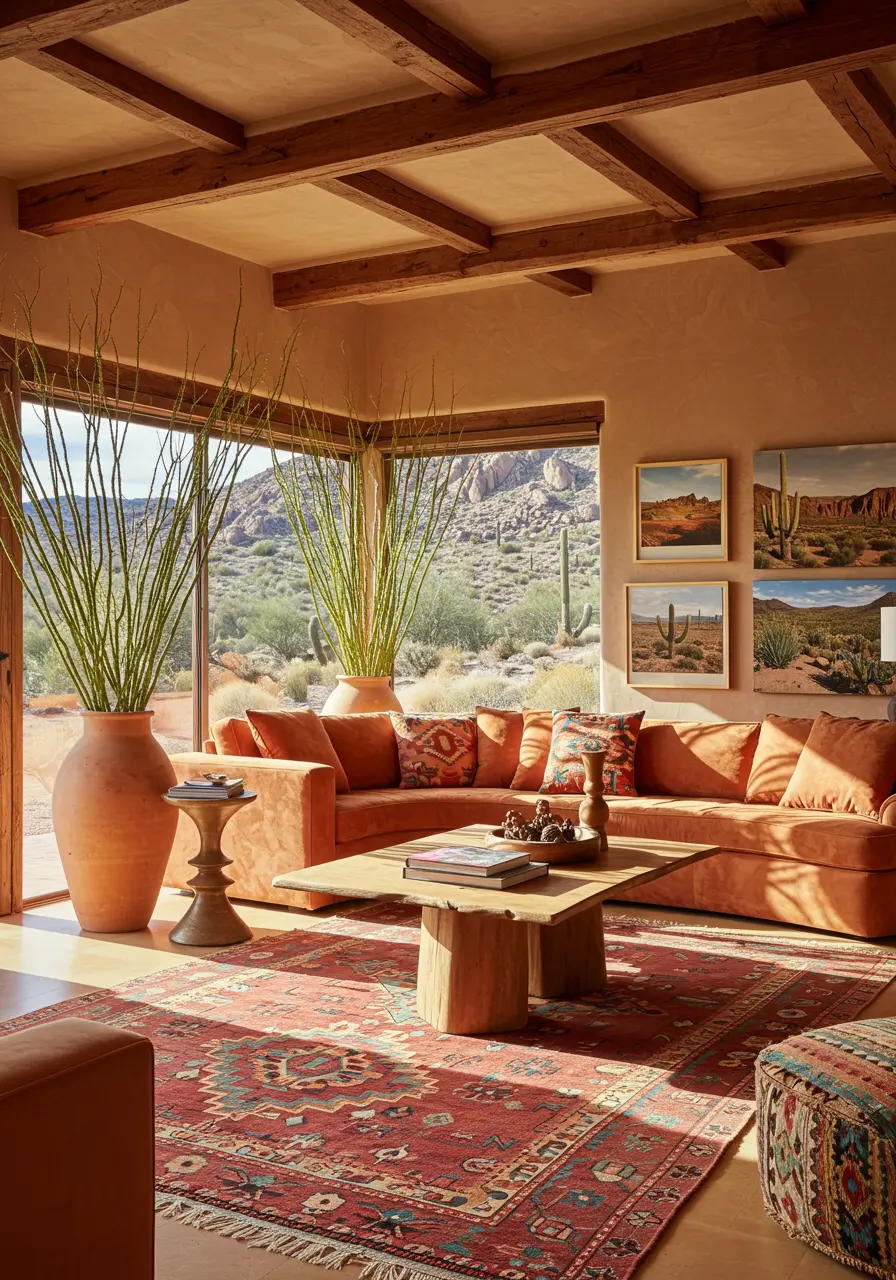
When your living room opens to a stunning natural landscape, extend that connection inward through your design choices.
Paint an accent wall in a warm, inviting terracotta tone to echo the sun-baked earth outside, instantly infusing the room with regional character.
Opt for large-scale terracotta pots to house architectural desert plants, bringing significant natural elements inside and mirroring the outdoor scenery.
A vibrant, handwoven rug with tribal patterns can ground the seating area, introducing rich color and a sense of heritage.
Ensure your furniture, like a plush burnt orange sofa, offers comfortable, expansive seating that encourages lingering and appreciation of the views.
6. Layered Grandeur: A Tapestry of Textures and Light
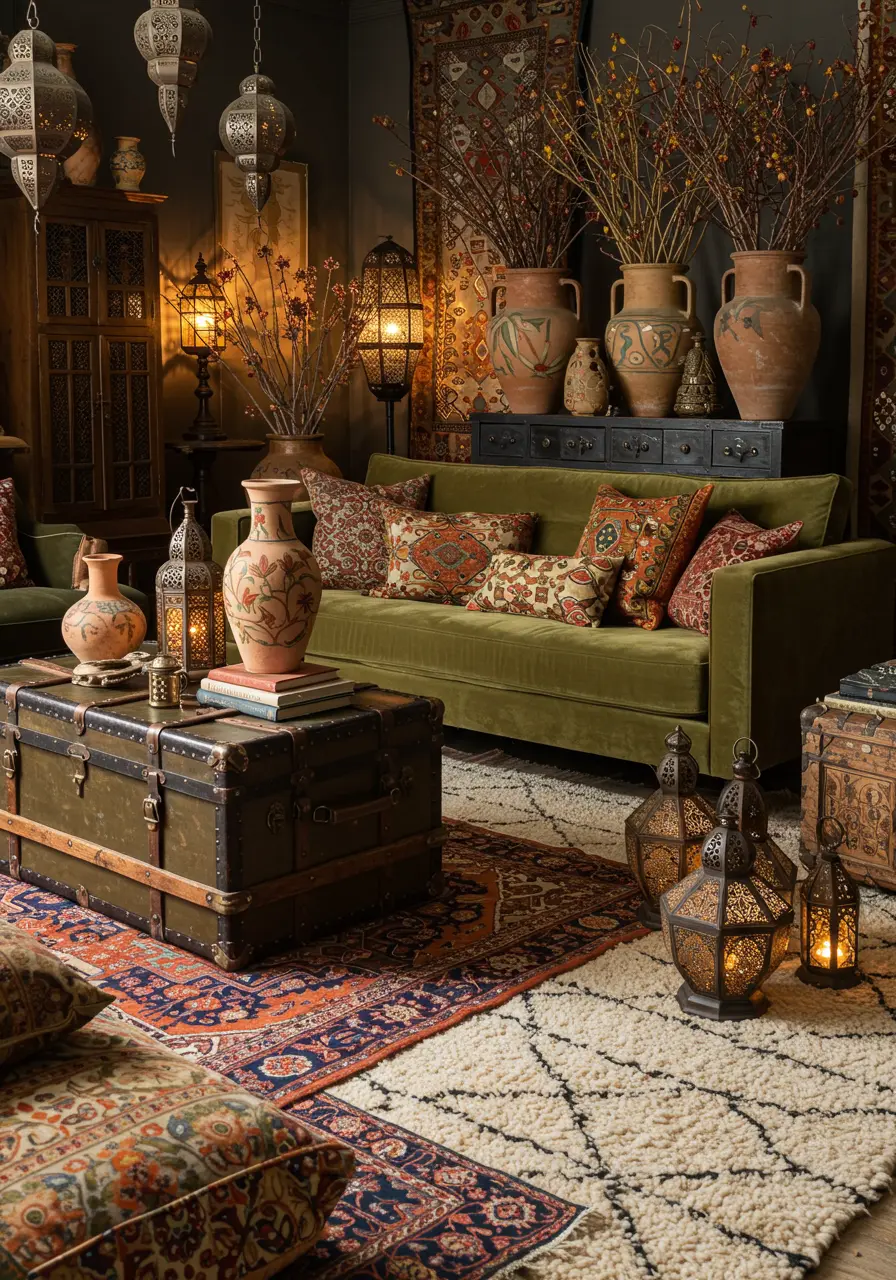
For a truly immersive and opulent living room, embrace the art of layering: patterns, textures, and light.
Begin with a foundational, soft-hued wool rug, then layer smaller, intricately patterned rugs on top to delineate seating zones and add visual depth.
An olive-green velvet sofa introduces a luxurious touch, its deep color a perfect counterpoint to the warm earthy tones.
Integrate a diverse collection of ornate lanterns and lamps at varying heights to cast a warm, inviting glow, creating intimate pockets of light.
Finally, curate your collection of terracotta vessels and decorative objects, using them to tell a story and add personal character to the space.
7. Softening Industrial Edge with Organic Forms
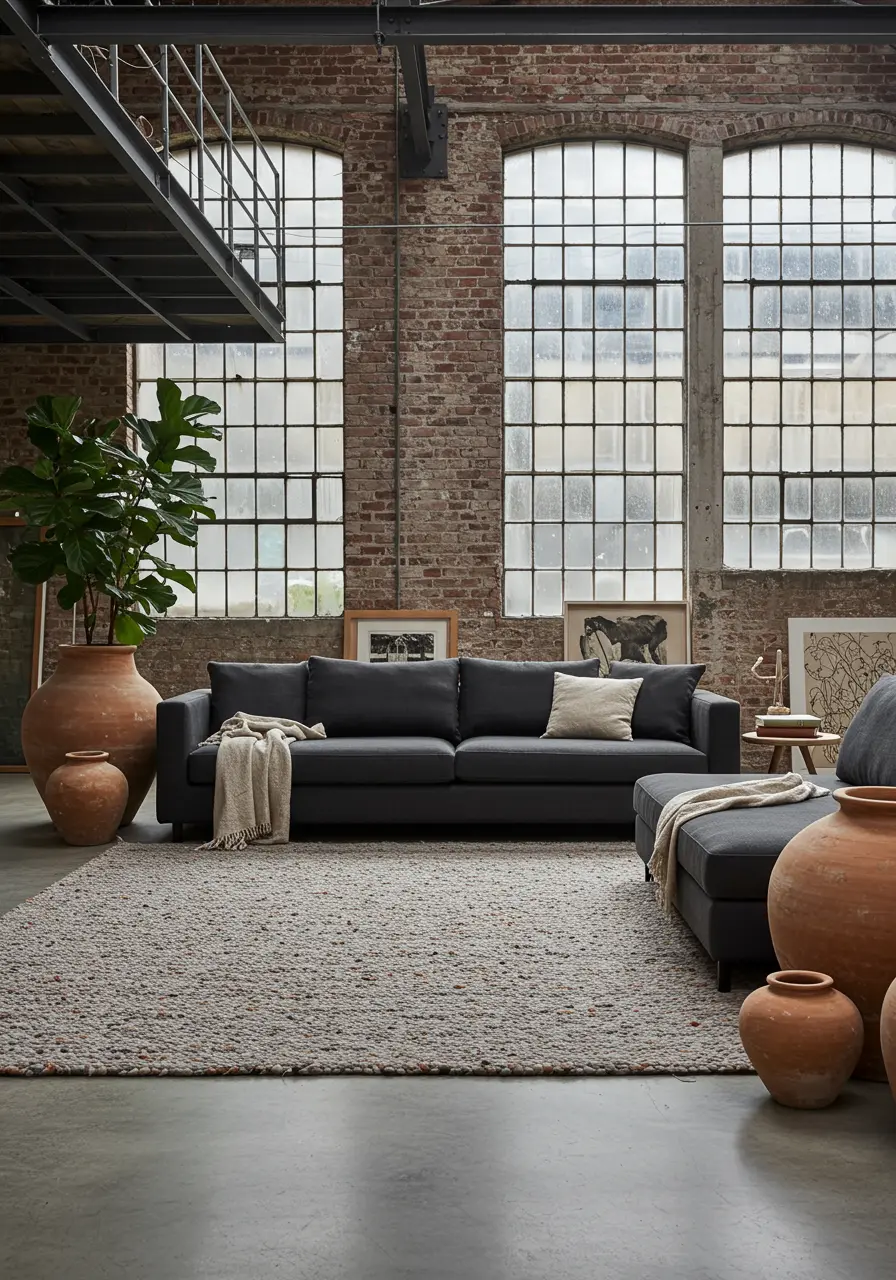
In spaces with industrial elements like exposed brick and steel-framed windows, introduce softness and warmth through contrasting materials.
A large, deep-seated sectional in a dark, grounding hue provides ample comfort and a sophisticated anchor for the room.
Roll out a textured, neutral-toned area rug with a subtle pattern to absorb sound and provide a soft counterpoint to hard surfaces.
Incorporate significant natural elements, such as a large, leafy indoor tree, placed in an oversized terracotta planter to add life and organic form.
These large-scale gestures are key to balancing the raw industrial aesthetic with a sense of refined comfort.
8. Nordic Warmth: Curated Simplicity on Display

Even in a minimalist aesthetic, warmth is paramount, achieved through natural materials and thoughtful curation.
Opt for furniture with clean lines and light-toned wood frames, allowing the craftsmanship to speak for itself.
Utilize floating wall shelves to display a precisely arranged collection of terracotta vases, varying their heights and forms for a dynamic yet uncluttered look.
Introduce a muted, subtly patterned rug to add a touch of texture and define the seating area without overwhelming the space.
Small, artful details, like a single framed print in warm tones, reinforce the cohesive and inviting atmosphere.
9. Timeless Elegance: Blending Periods with Ease

Achieve a timeless living room by thoughtfully blending traditional elements with contemporary comfort.
A classic fireplace with a marble surround serves as a distinguished focal point, around which you can arrange comfortable, neutral-toned seating.
Position a large mirror above the mantel; it not only reflects light to expand the sense of space but also doubles the impact of your mantel decor.
For grounding the room, select a handwoven rug with a faded, intricate pattern that introduces a sense of history and softness underfoot.
On a console table, group large terracotta urns filled with dried botanicals, offering an organic contrast to the room’s more structured elements.
10. Rustic Retreat: Anchoring with Stone and Wood
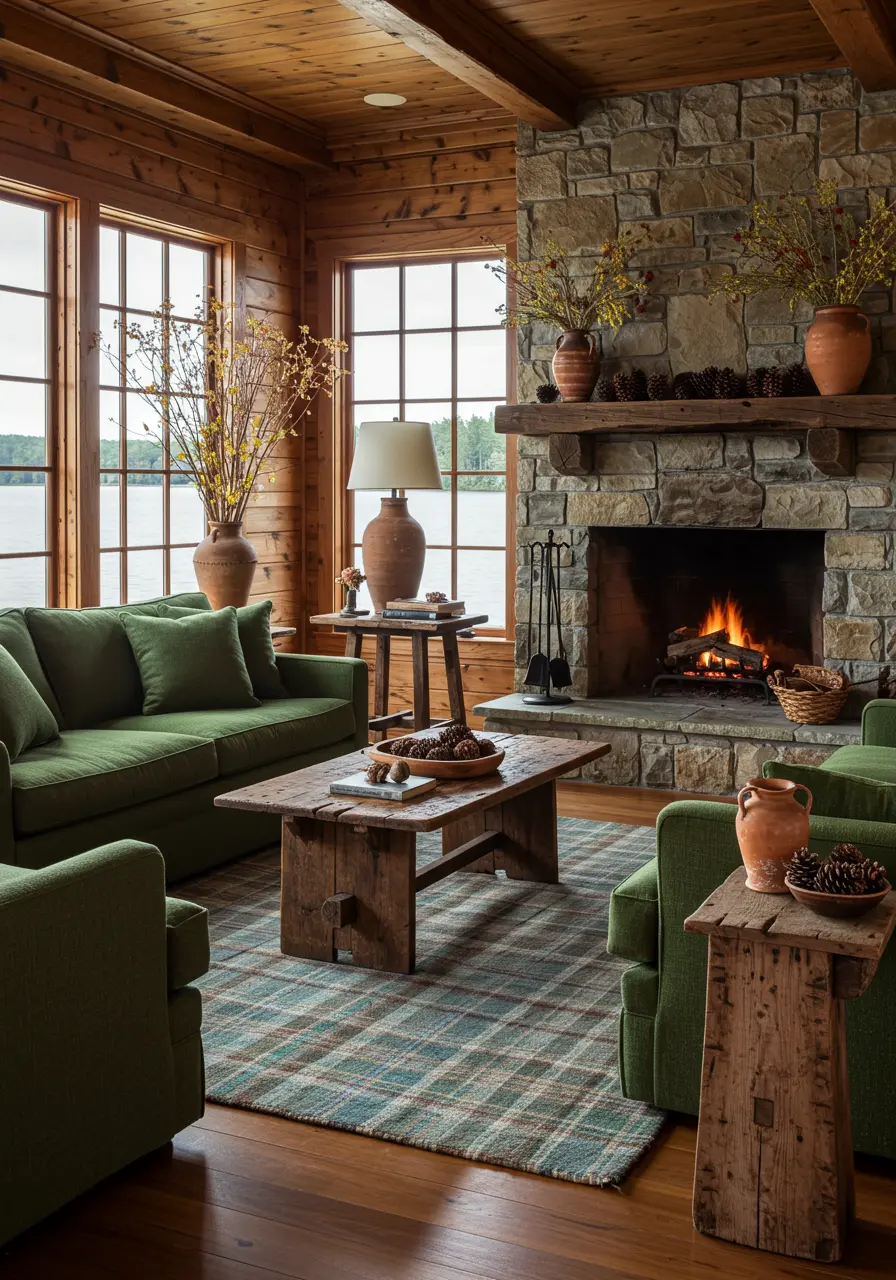
In a rustic setting, embrace the inherent beauty of natural materials by allowing them to dictate your palette and textures.
A robust stone fireplace creates a commanding presence; accentuate its scale with large, statement-making terracotta vases on the mantel.
Pair exposed wooden walls and ceilings with plush, deep-seated sofas in a rich, inviting color like forest green, offering a soft counterpoint to the hard surfaces.
Choose a durable, plaid-patterned wool rug to define the seating area, providing both warmth and a touch of classic lodge charm.
Complete the tableau with sturdy, reclaimed wood coffee and side tables that echo the room’s inherent connection to nature.
11. Global Inspiration: Vibrant Hues and Intricate Details
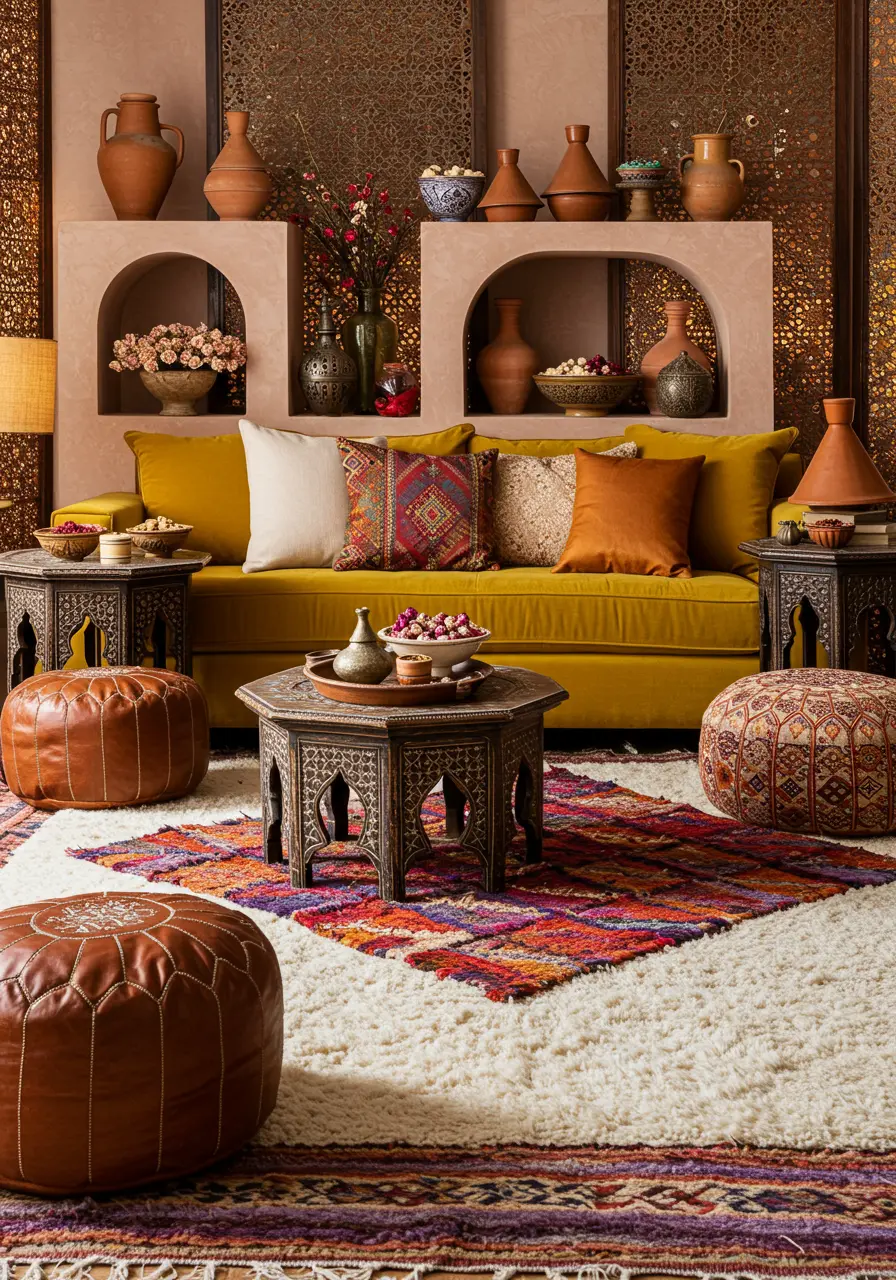
To infuse your living room with a rich, globally inspired aesthetic, embrace a bold color choice for your main seating, such as a vibrant mustard yellow sofa.
Layer multiple handwoven rugs with contrasting patterns and textures to create a rich tapestry on the floor, delineating areas and adding profound visual interest.
Incorporate unique architectural features like built-in niches, using them to artfully display a collection of diverse terracotta and ceramic vessels.
Source intricate, detailed side tables and poufs that bring a handcrafted sensibility and additional texture to the space.
This maximalist approach thrives on thoughtful curation, ensuring each piece contributes to a cohesive, exotic narrative.
12. Open-Plan Harmony: Defining Zones with Scale
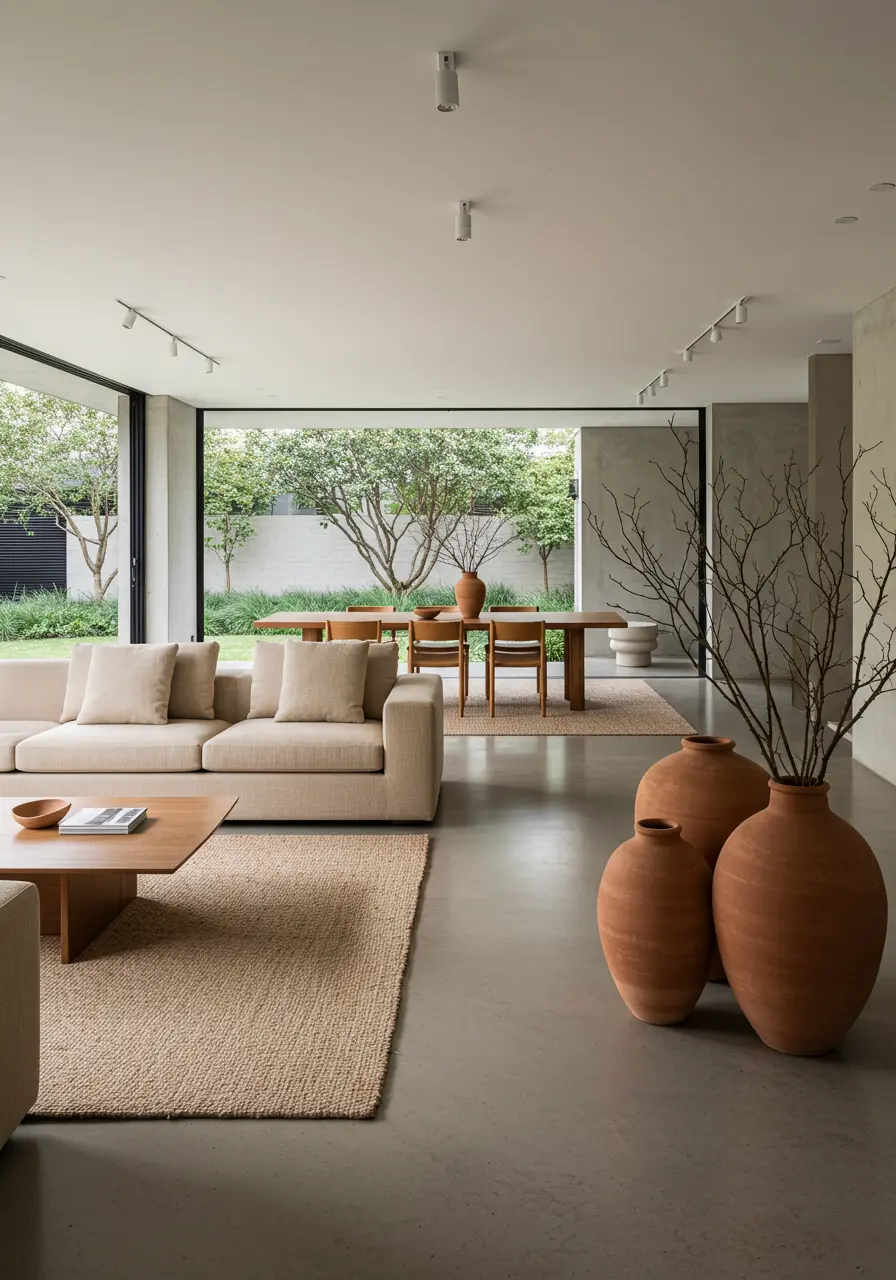
In an open-plan environment, create a sense of cohesion while subtly defining distinct zones through scale and consistent material choices.
A generously sized, low-profile sofa in a neutral tone provides a comfortable anchor for the living area, promoting an airy feel.
Extend your connection to the outdoors by using large, impactful terracotta planters with sculptural branches as a visual link between your interior and exterior spaces.
A natural fiber rug, such as jute or sisal, helps delineate the living zone and adds a grounding, organic texture.
Maintain a minimalist approach to accessories on your coffee table, allowing the expansive views and natural elements to be the primary focus.
13. The Intimate Conversation Pit: Light and Texture
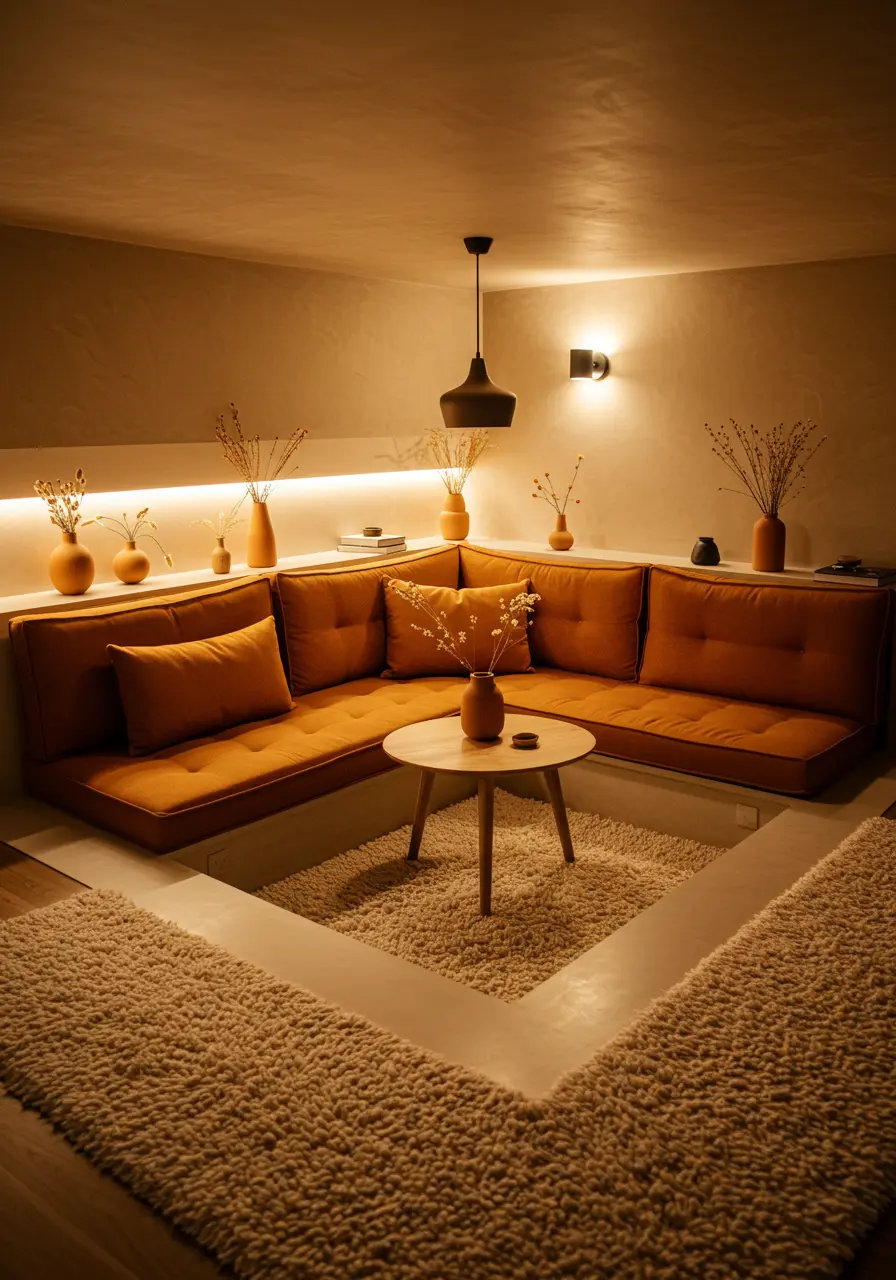
A sunken living area, or conversation pit, offers an unparalleled opportunity for creating an intimate and inviting space.
Emphasize this coziness by selecting plush, built-in upholstery in a warm, enveloping color like burnt orange or amber.
Integrate subtle ambient lighting, such as LED strips along ledges, to cast a soft, upward glow that enhances the architectural feature.
A deep, shaggy rug within the pit provides immediate comfort and acoustic dampening, making conversations feel more private and relaxed.
Style the surrounding ledges and a petite central coffee table with a collection of smaller terracotta vases and organic objects to complete this secluded retreat.
14. Compact Comfort: Vertical Styling and Clean Lines
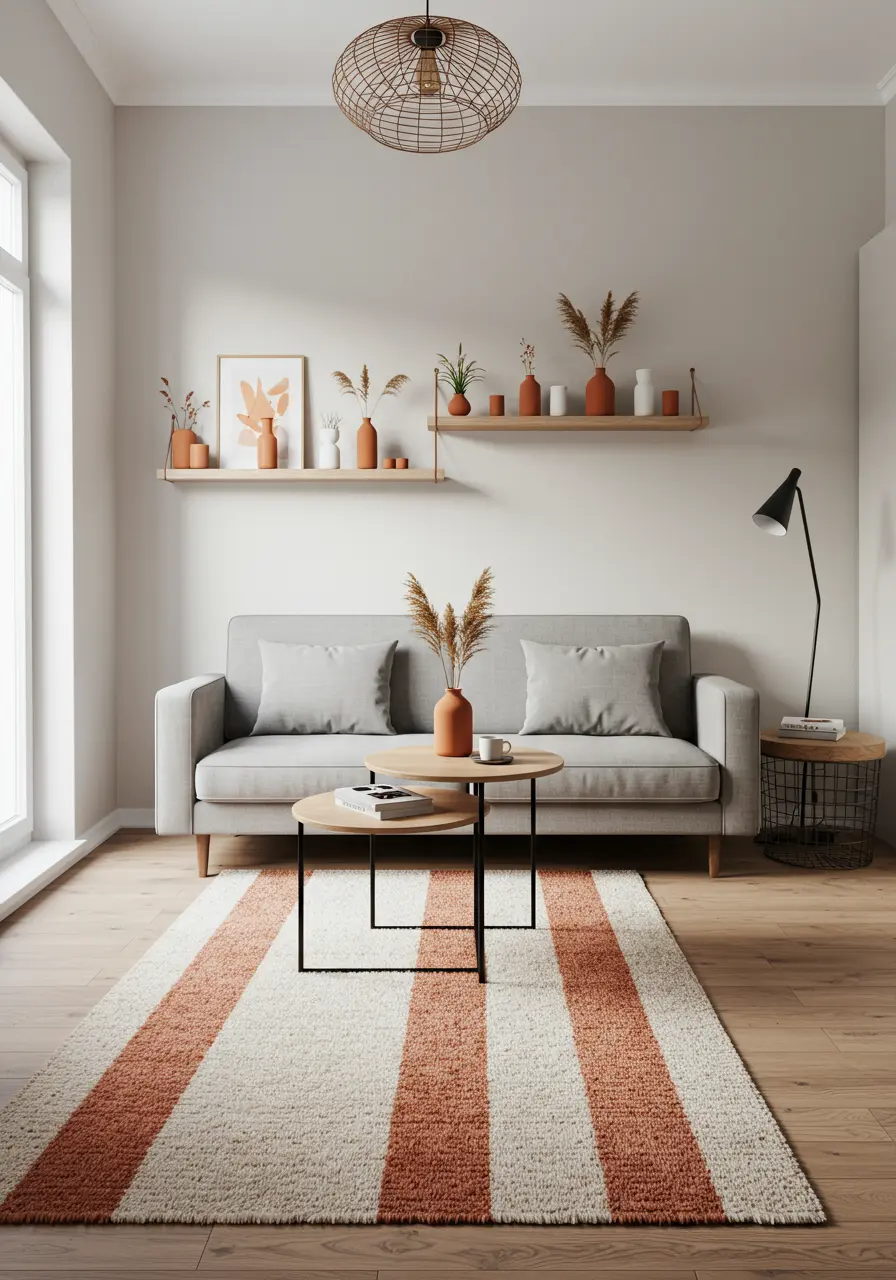
In smaller living rooms, prioritize furniture with clean lines and a lighter visual footprint to prevent the space from feeling cramped.
A sleek, compact sofa in a neutral shade allows the room to feel more expansive while providing essential seating.
Instead of bulky end tables, opt for nested coffee tables or slim, multi-level designs that offer flexibility and don’t overwhelm the floor plan.
Utilize vertical space by installing floating shelves; these are perfect for displaying a curated collection of small terracotta vases and art without consuming precious floor area.
A striped or graphic area rug can visually elongate the room, guiding the eye and adding a touch of playful sophistication.
15. Attics Transformed: Maximizing Unique Angles

Attic living rooms present a unique design challenge and opportunity, with their sloped ceilings and skylights.
Embrace the angles by selecting furniture that is lower in profile or allows for comfortable positioning under the slopes, such as a compact sofa and armchairs in a soft, inviting color.
Leverage skylights as primary light sources, understanding how they cast dramatic shadows and bright pools of light throughout the day.
A rustic wooden trunk can serve as a multi-functional coffee table, offering storage and a sturdy surface for displaying a cluster of terracotta vases.
Ground the space with a geometric patterned rug, whose lines can echo and soften the room’s architectural angles.
16. Conservatory Charm: Blurring Indoor and Outdoor
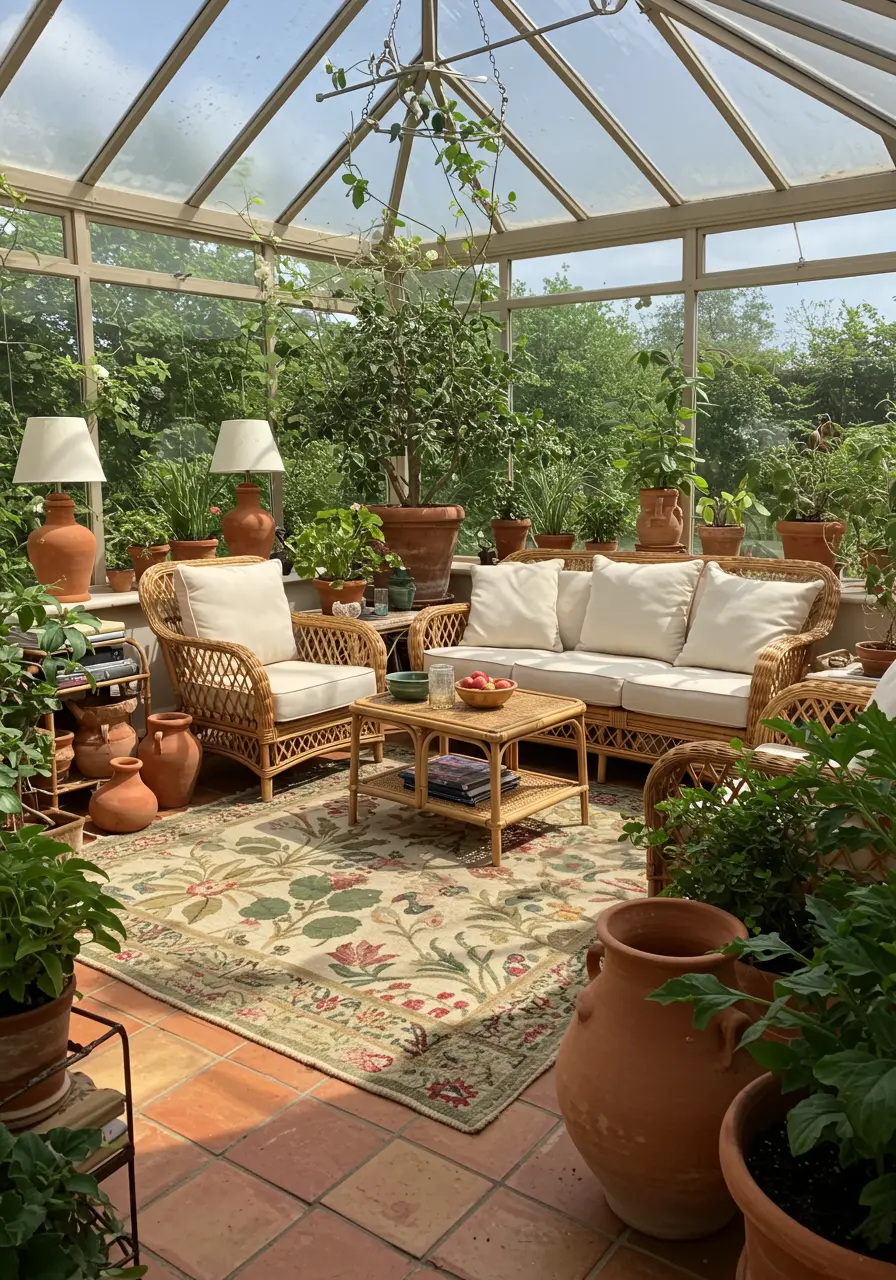
A conservatory or sunroom naturally invites an abundance of plants, blurring the lines between indoor comfort and outdoor serenity.
Furnish with natural materials like wicker or rattan, which effortlessly complement the green surroundings and durable terracotta floor tiles.
Anchor the seating area with a botanical-patterned rug; its colors and motifs will echo the lush foliage and add a touch of refined artistry.
Embrace the proliferation of plants, arranging them in a variety of terracotta pots of different sizes and shapes, creating a verdant tableau.
Ensure adequate lighting for both day and evening use, with lamps that cast a soft glow on your green sanctuary.
17. The Grand Library: Statuesque Decor
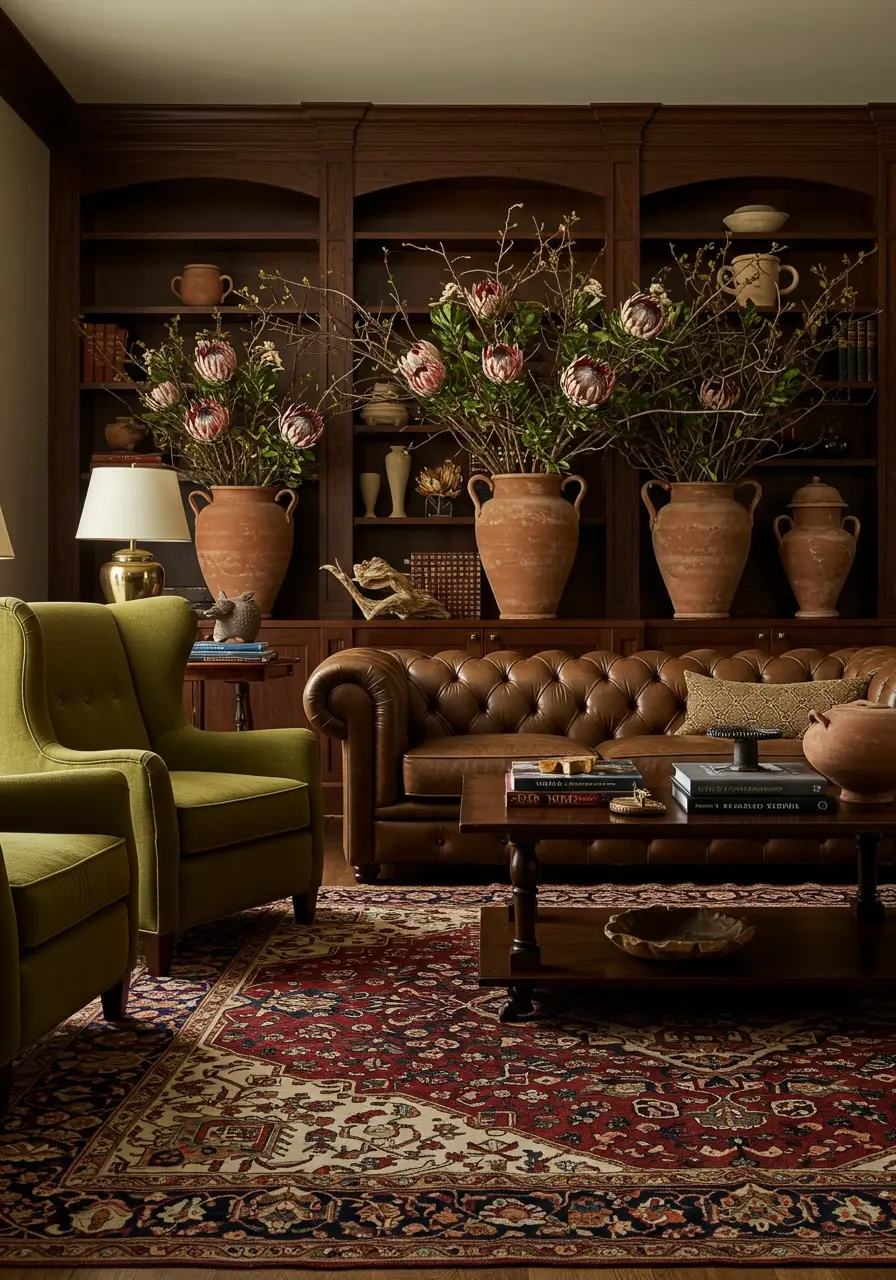
In a living room designed for depth and quiet contemplation, such as a home library, leverage height and scale to create a sense of grandeur.
Utilize dark, built-in bookshelves to frame the room, providing ample storage and a sophisticated backdrop for your collection.
For seating, a rich leather Chesterfield sofa paired with deep-toned armchairs invites leisurely reading and conversation.
Introduce dramatic, oversized terracotta urns filled with bold, sculptural branches or dried flowers to add a focal point and organic contrast against the structured shelves.
A finely detailed, large-scale Oriental rug will anchor the entire composition, adding a layer of intricate pattern and warmth underfoot.
18. Mid-Century Warmth: Playful Color and Form
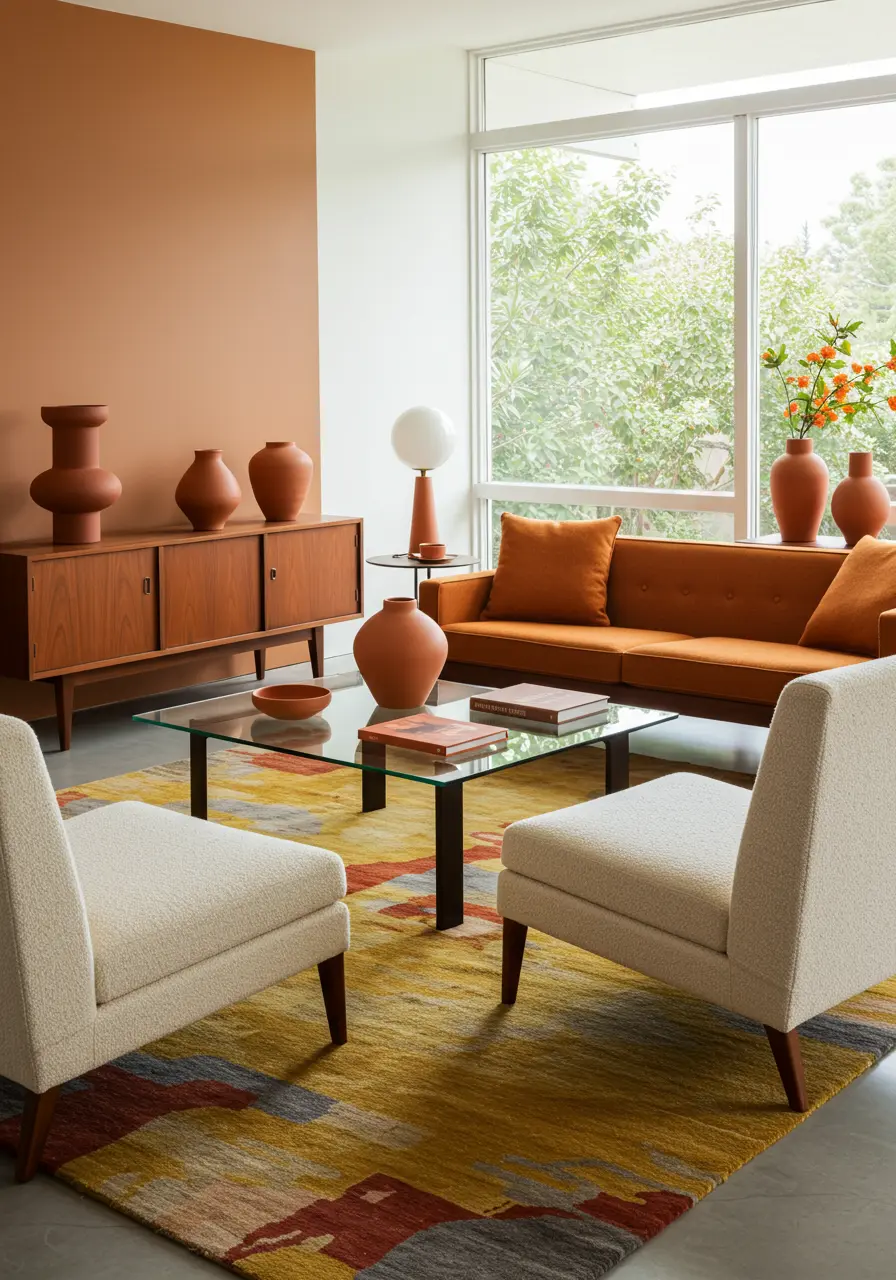
Infuse a mid-century modern living room with warmth by introducing a terracotta accent wall; its rich hue will instantly define the space and complement teak wood furniture.
Select seating in a complementary burnt orange or mustard tone, ensuring clean lines and comfortable proportions.
A clear glass coffee table maintains an open, airy feel, allowing the patterns of your rug to shine through without interruption.
Curate a collection of terracotta vases with varied, playful forms on your sideboard, drawing the eye with their sculptural quality.
Ground the entire ensemble with an abstract-patterned rug that introduces a dynamic interplay of color and texture.
19. The Refined Study: Books, Leather, and Warm Light
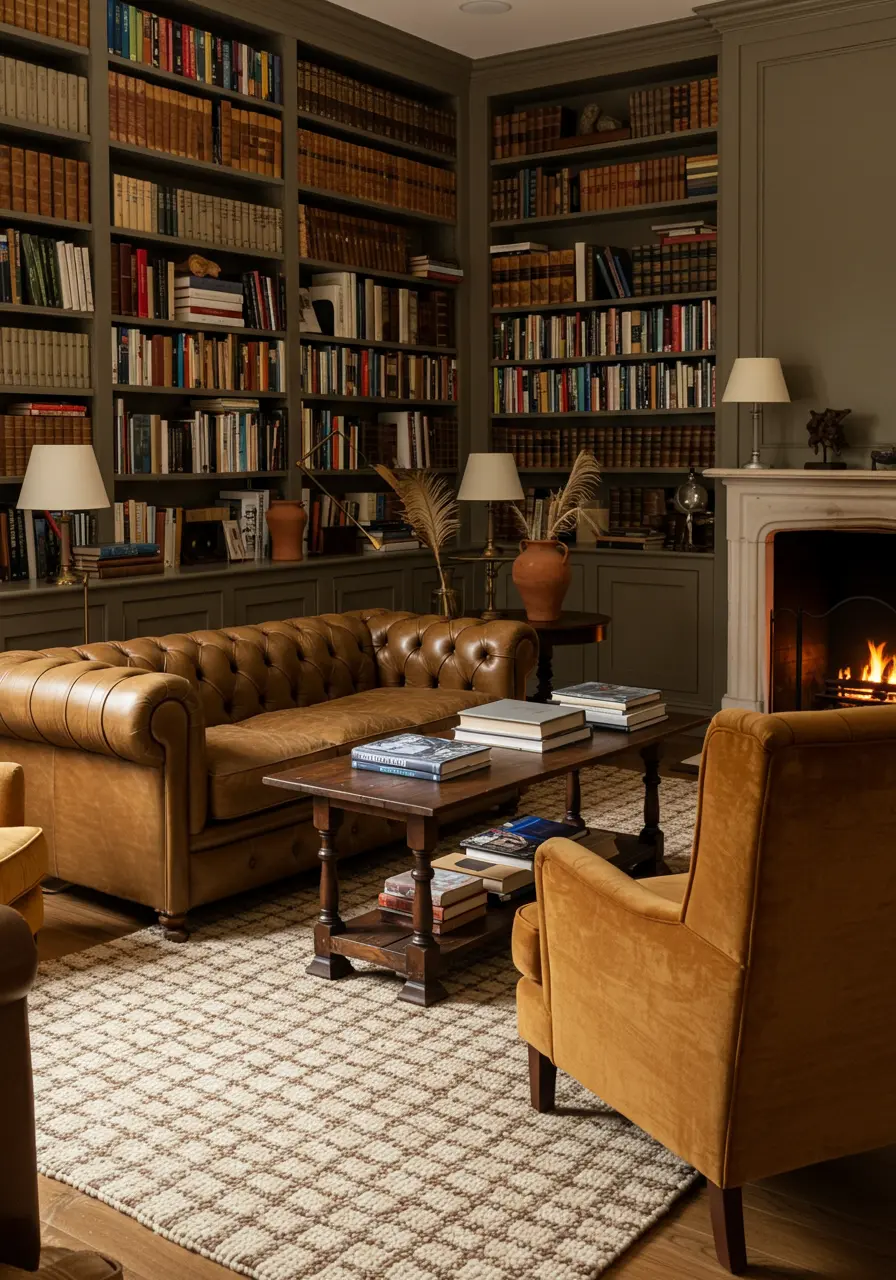
Transform a living room into a sophisticated study or personal retreat by prioritizing deep comfort and intellectual stimulation.
Full-height bookshelves in a rich, dark hue create an enveloping atmosphere, inviting hours of quiet contemplation.
Anchor the space with a classic leather Chesterfield sofa, its sturdy presence offering enduring style and comfort.
Layer in a subtly patterned wool rug that adds warmth and acoustic softness, making the room feel more intimate and inviting.
Ensure your lighting plan includes various task and ambient lamps, providing focused light for reading and a soft, overall glow that enhances the room’s cozy ambiance.
20. Biophilic Bliss: Embracing the Outdoor View
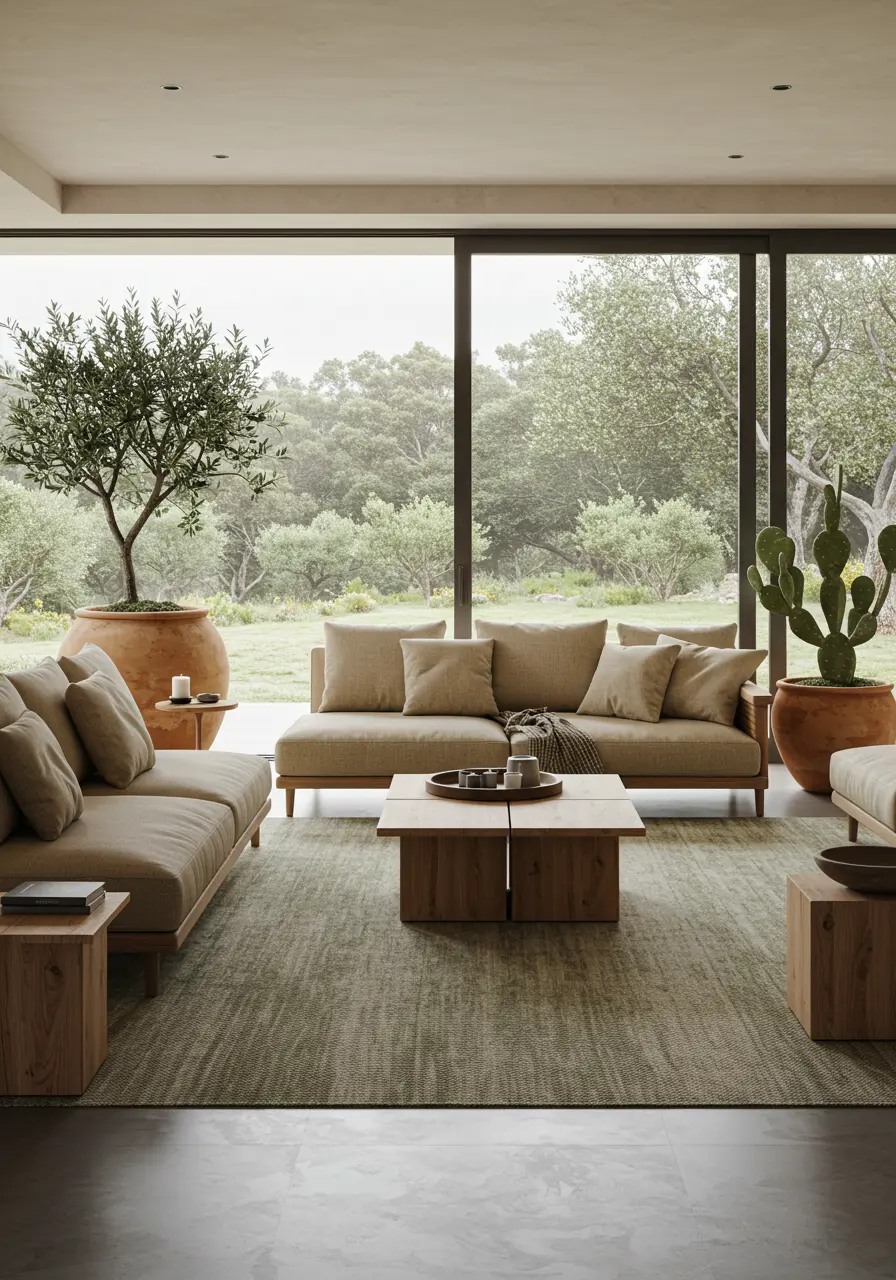
When your living room boasts expansive views of nature, design your interior to seamlessly integrate with the outside.
Opt for a muted, earthy color palette for your large-scale furniture, allowing the greens and blues of the landscape to be the primary colors.
Introduce large, living plants in substantial terracotta pots, such as an olive tree or a striking cactus, acting as sculptural elements that bridge indoors and out.
A textured rug in a natural green or beige hue will ground the seating area, mirroring the organic textures of the surrounding environment.
Maintain an uncluttered aesthetic to keep the focus on the serene view and the natural elements within the space.
This thoughtful approach makes your living room a true sanctuary connected to the natural world.
21. Streamlined Style for Narrow Spaces

In a narrower living room, every piece should be chosen for its ability to enhance spaciousness and utility.
Select a sofa with a compact profile and exposed legs to create a lighter visual footprint and allow more light to circulate.
Instead of a traditional coffee table, consider a small, round side table that can be easily moved, paired with a simple floating shelf along the wall.
This shelf is perfect for a curated display of small terracotta vases and dried botanicals, adding personality without cluttering the floor.
A long, striped or patterned runner rug can visually elongate the room, guiding the eye and adding warmth without overwhelming the limited floor area.
22. The Comfort of a Neutral Palette
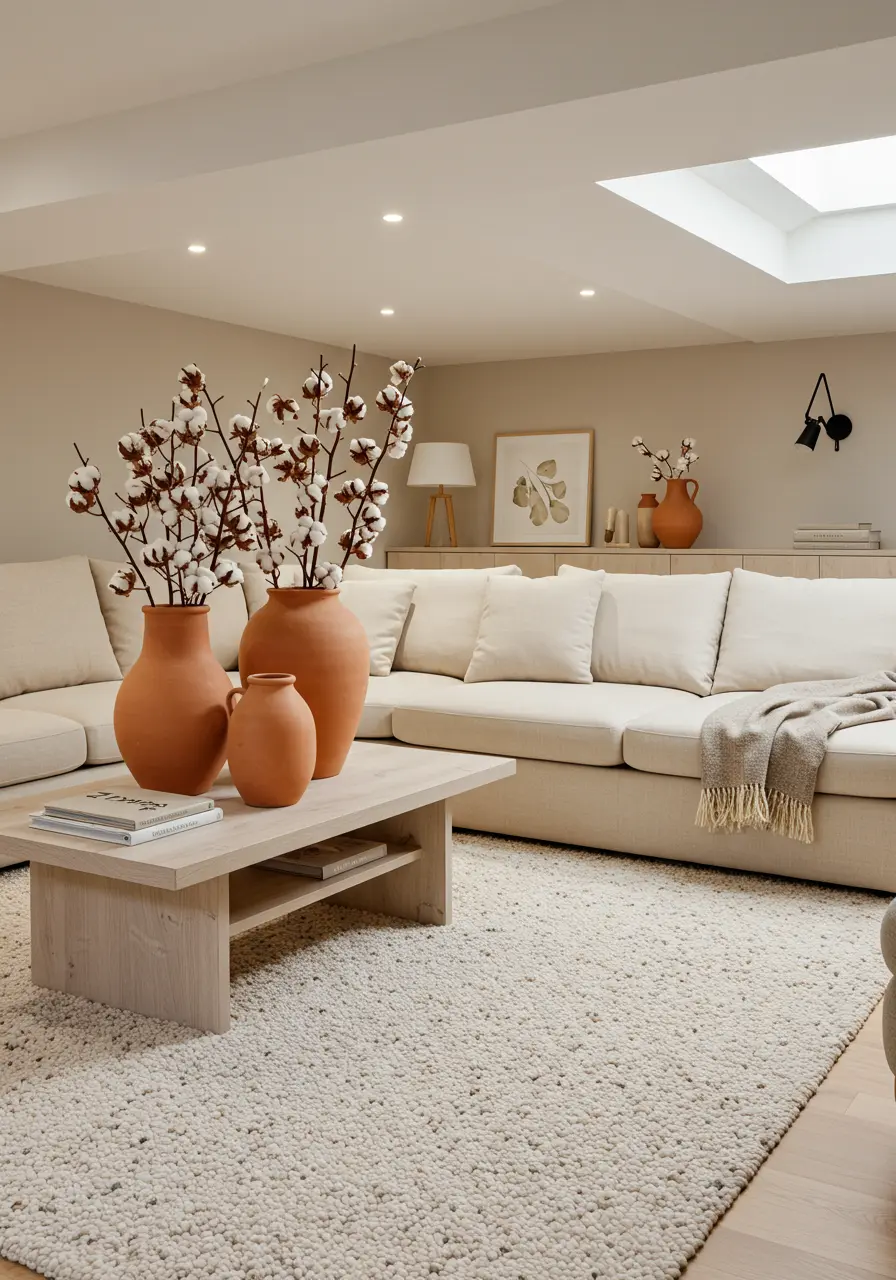
A neutral color palette creates an inherently calming and versatile living space, allowing textures and natural light to take center stage.
Invest in a large, comfortable sectional sofa in a light, inviting fabric, providing ample seating for relaxation and entertaining.
Ground the entire area with a deeply textured, shaggy rug; its tactile quality adds a luxurious layer of warmth and comfort underfoot.
Introduce natural elements with sculptural impact, such as oversized terracotta vases filled with dramatic cotton branches, to add organic interest and height.
Leverage natural light sources like skylights, ensuring they are unobstructed to flood the room with a gentle, ambient glow that enhances the neutral tones.
23. Symmetrical Grandeur: A Balanced Statement
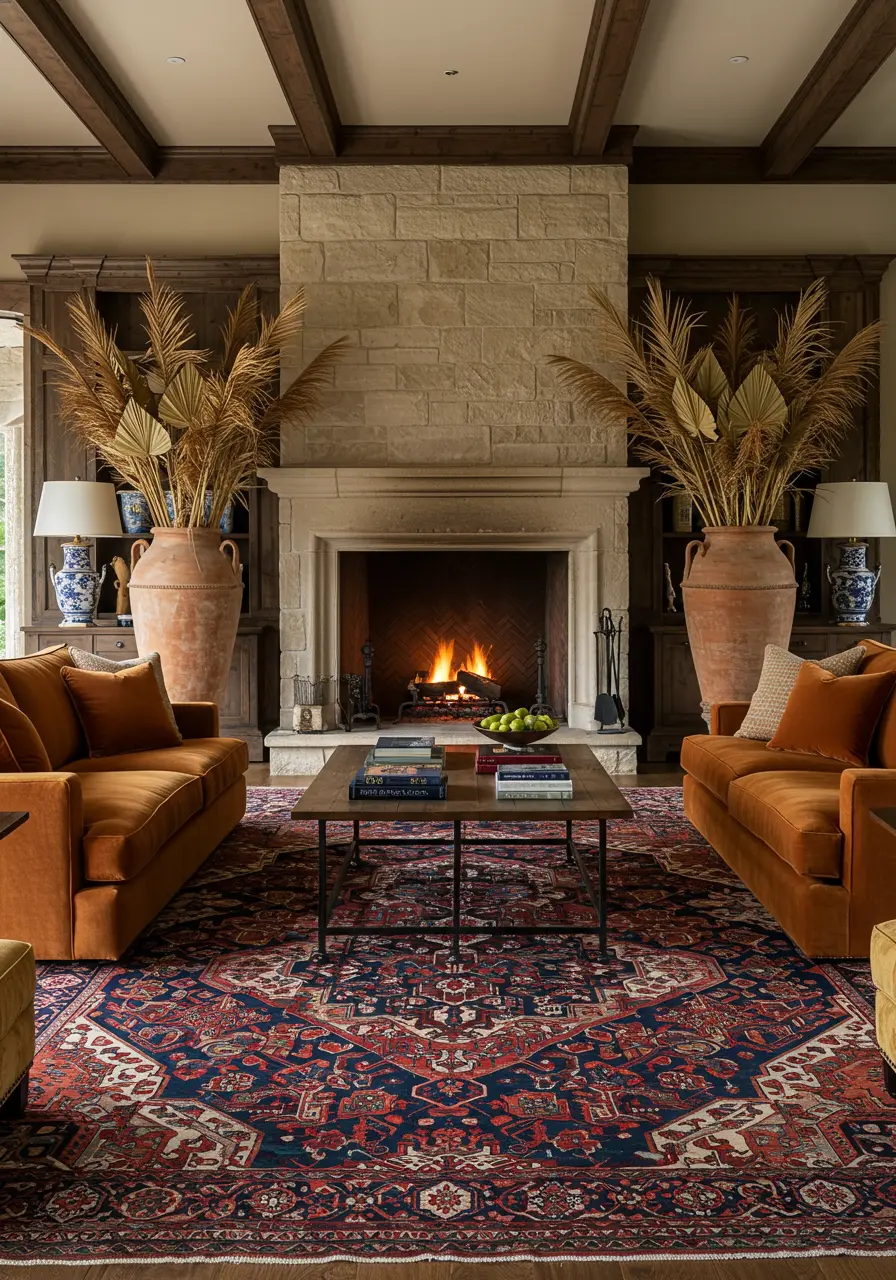
Create a sense of formal balance and grandeur by arranging your furniture symmetrically around a central focal point, such as a magnificent fireplace.
Opt for a pair of plush sofas in a rich, inviting hue like burnt orange or rust, facing each other to encourage conversation and provide visual symmetry.
Anchor the entire composition with a substantial, intricately patterned Persian rug; its deep colors and complex design will provide a luxurious foundation.
On either side of the fireplace, place monumental terracotta urns filled with striking dried botanicals, emphasizing height and scale.
The meticulous placement of each element contributes to a feeling of sophisticated order and timeless elegance.
24. Architectural Play: Layering Levels and Decor
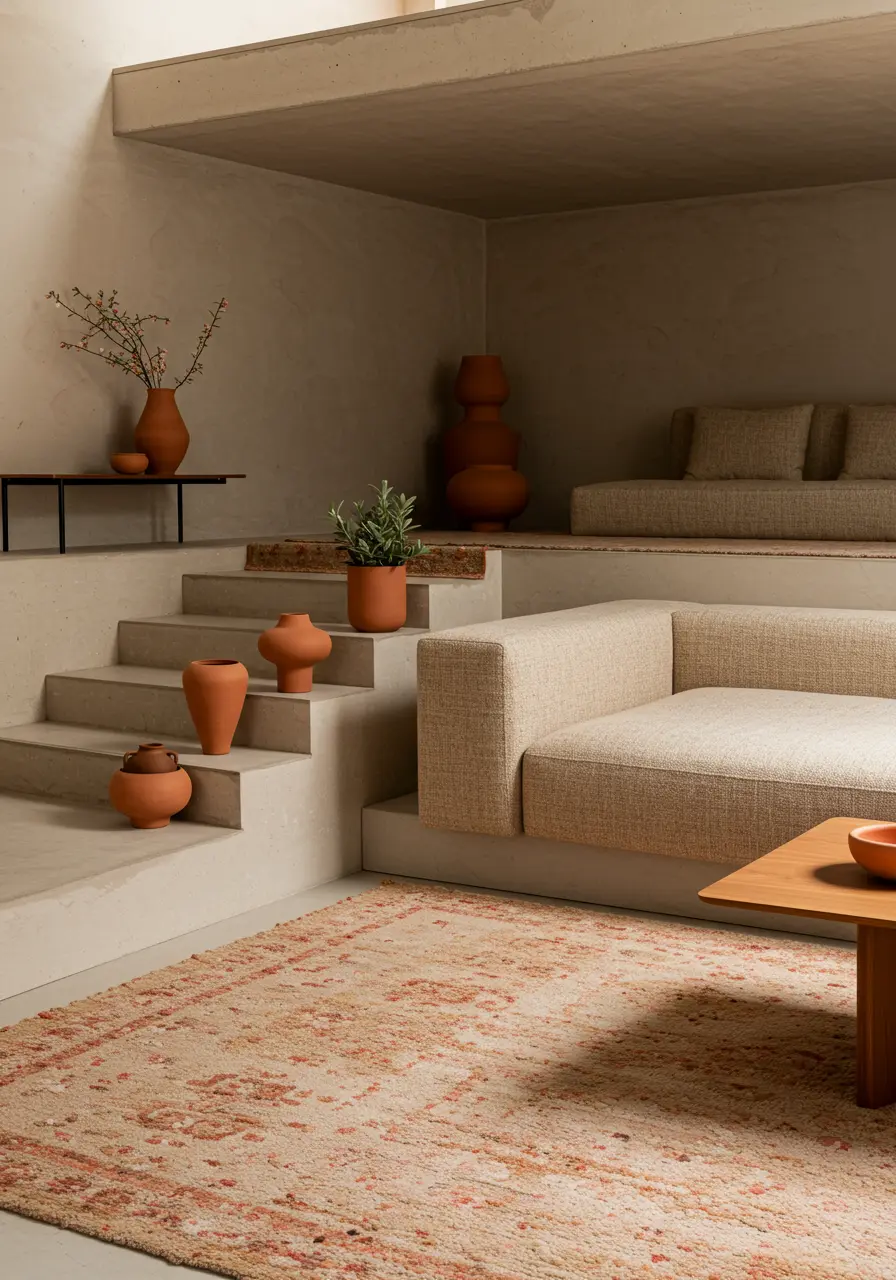
When your living space incorporates multi-level architecture, use these inherent features to create dynamic display opportunities.
Style the steps and ledges with a thoughtfully arranged collection of terracotta vases, varying their sizes and forms to lead the eye upwards.
Maintain a cohesive, muted color palette for your built-in seating and walls to allow the architectural forms and pottery to stand out.
A subtly textured area rug in a complementary tone will soften the hard lines of the concrete, adding an inviting layer of warmth.
This approach transforms functional elements into sculptural backdrops for your curated collection, making the space feel both artful and livable.
25. Artful Statements: Rug as Masterpiece
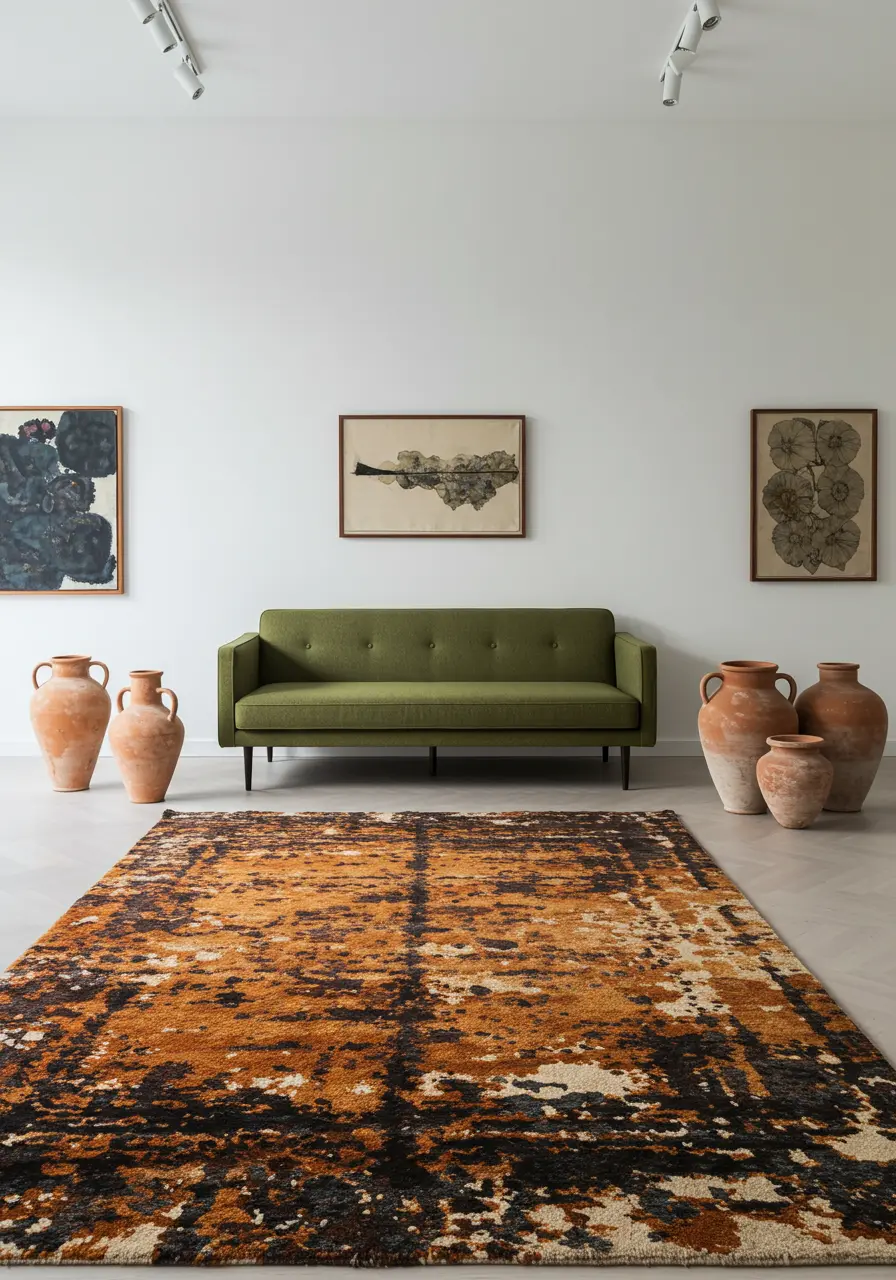
In a gallery-like setting with clean, uncluttered walls, allow a single, impactful element to serve as the room’s primary art piece.
A large, abstract patterned rug with a rich, earthy color palette can define the entire living area, drawing the eye and grounding the space with its artistry.
Choose a streamlined sofa in a solid, contrasting color, such as a deep olive green, to provide a calm anchor against the rug’s vibrancy.
Instead of traditional wall art, place large, sculptural terracotta pots on the floor at varying points to introduce organic forms and texture.
This minimalist approach ensures that the chosen statement pieces truly shine, creating a sophisticated and considered environment.
Consider this a masterclass in how selecting the perfect area rug can transform a room.
26. Seamless Indoor-Outdoor Living
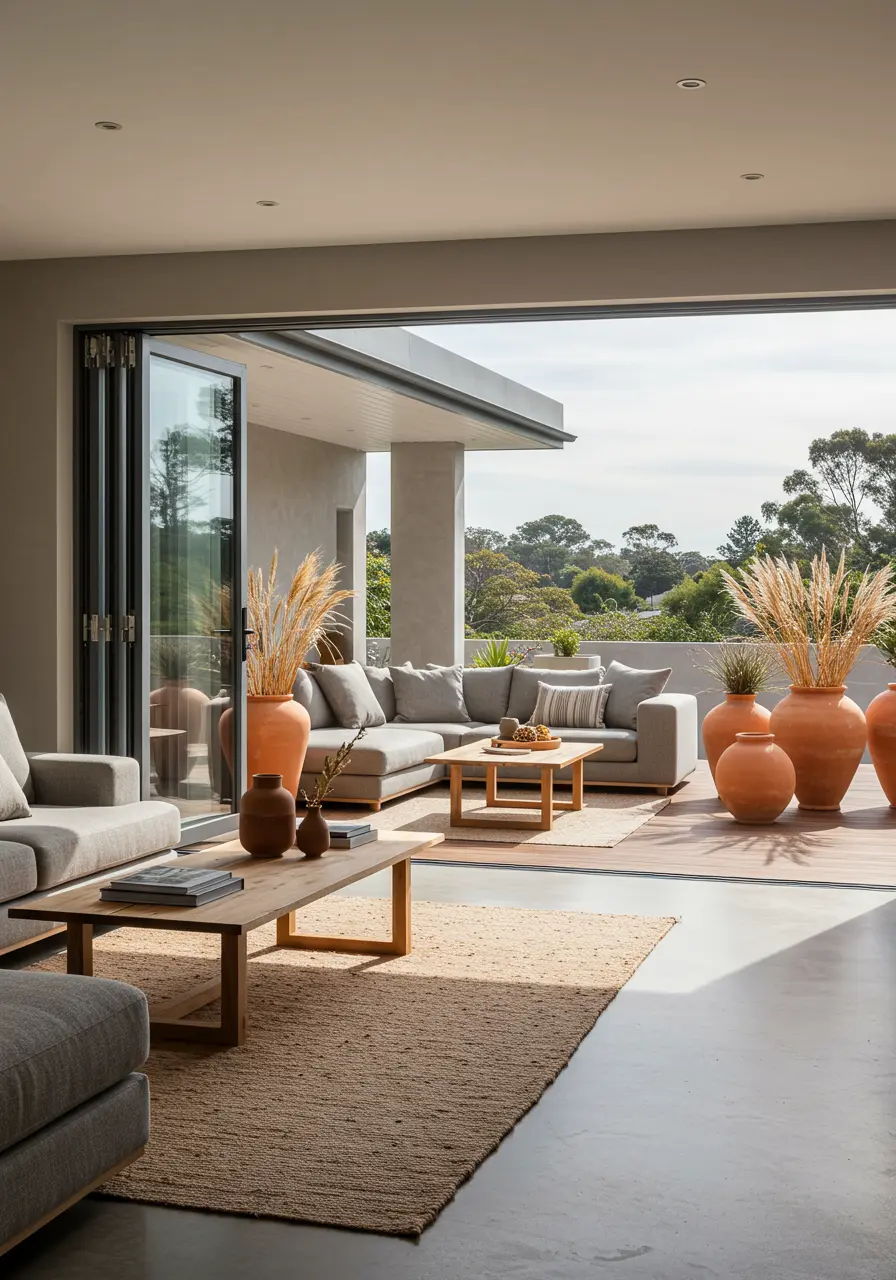
For homes with expansive openings to an outdoor living space, ensure visual continuity by extending your interior design choices outwards.
Select durable, weather-appropriate outdoor furniture that mirrors the style and comfort of your indoor seating, creating a cohesive aesthetic.
Utilize natural fiber rugs, like jute or sisal, both indoors and out to provide a consistent textural foundation and define seating zones.
Incorporate significant natural elements in large terracotta planters on both sides of the threshold, creating a visual bridge between the two areas.
This thoughtful approach maximizes the sense of space and flow, making your entire home feel connected to its environment.
27. Zen Simplicity: Low-Profile Comfort
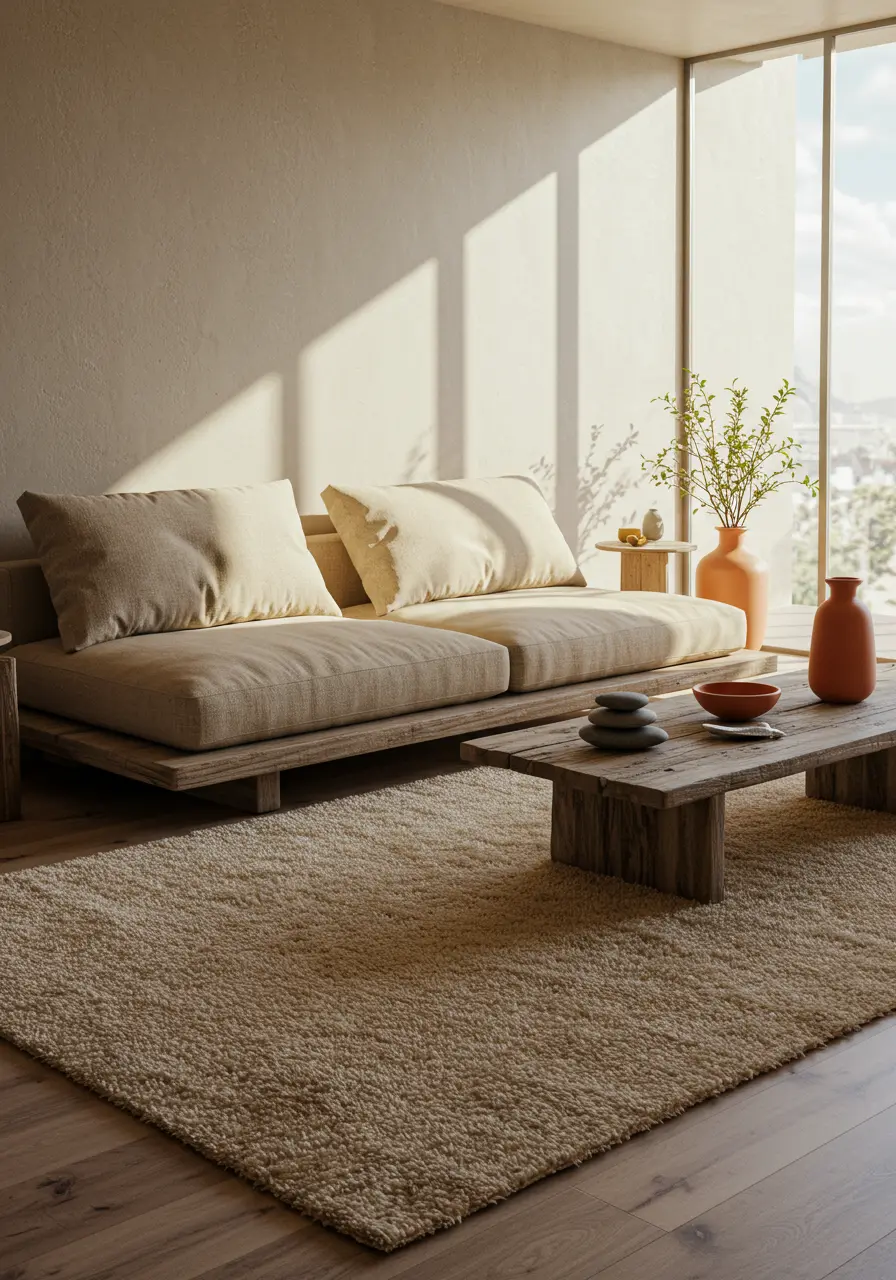
Cultivate a sense of calm and expansive space by opting for low-profile furniture that visually expands the height of your ceilings.
A simple, platform-style sofa in a natural linen or cotton fabric provides a serene foundation for relaxation.
Pair this with a minimalist wooden coffee table and a soft, shaggy rug that invites bare feet and adds a layer of quiet luxury.
Allow natural light to flood the space, highlighting the subtle textures of your materials and casting beautiful shadows.
Place a few simple terracotta vessels near windows or on surfaces, introducing just enough organic form without disrupting the serene simplicity.
28. Personalized Retreat: Character in Collections
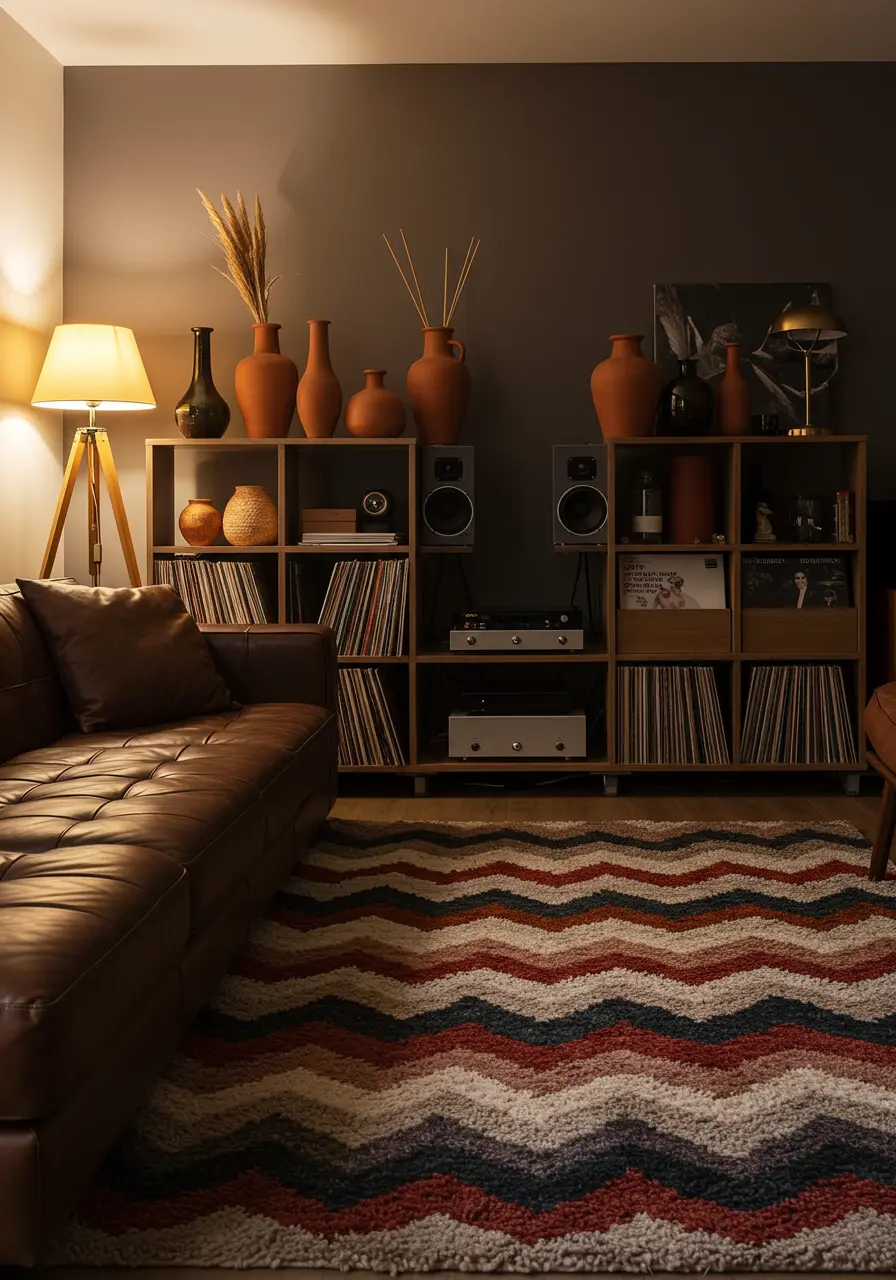
Your living room should tell your story, and integrating personal collections thoughtfully is key to achieving this.
Open shelving units are ideal for displaying beloved items, from vinyl records to cherished books and, of course, your collection of terracotta vases.
Vary the sizes and shapes of your pottery, arranging them in clusters or as individual statements to create visual interest.
Anchor the room with a graphic-patterned rug; its bold design can add energy and a touch of curated whimsy to the space.
Supplement overhead lighting with warm, ambient lamps at different heights, creating inviting pools of light that highlight your personalized displays and add to the room’s character.
29. Inviting Nooks: Thoughtful Seating Arrangements
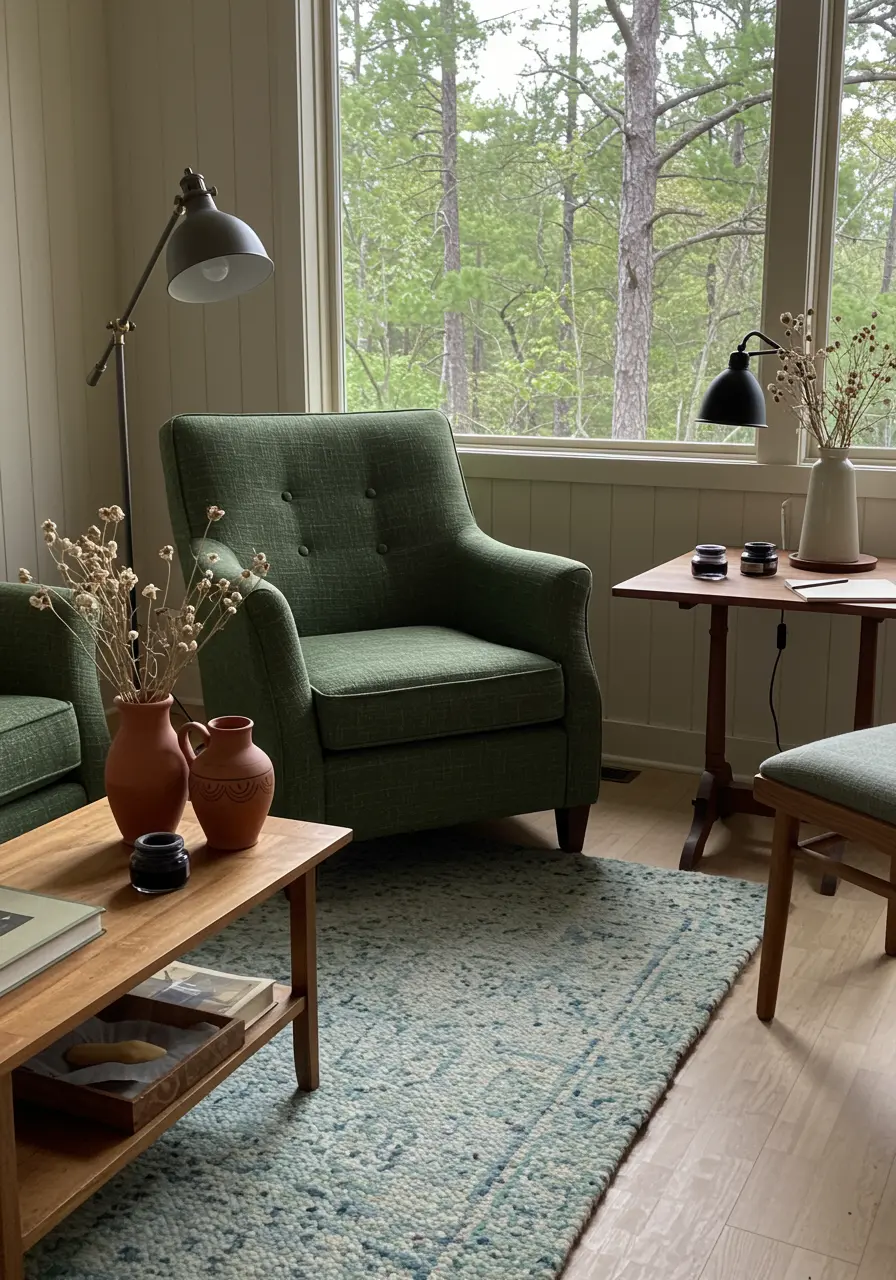
Create intimate seating zones within your living room, perfect for quiet conversation or personal retreat, by grouping comfortable armchairs.
Choose chairs in a harmonizing color, like a soft sage green, that complements warmer wood tones and natural textures.
Place small, functional side tables between chairs, perfect for a cup of tea or a book, adorned with a simple terracotta vase holding dried flowers.
Ground this seating arrangement with a textured rug in a coordinating light blue-green, adding softness and defining the area.
This thoughtful arrangement encourages relaxation and makes the most of available space, creating cozy pockets of comfort.
30. Modern Family Hub: Functional Flow and Warm Hues

Design a modern family living room that prioritizes both functionality and inviting warmth through intelligent layout and a balanced color palette.
A generous sectional sofa in a neutral, durable fabric offers ample seating for everyone, becoming the central hub of comfort.
Choose a coffee table that combines materials, like wood and metal, to introduce a subtle industrial edge while retaining warmth.
Anchor the entire space with an abstract-patterned rug featuring a blend of warm earth tones, tying together the room’s various elements and adding visual intrigue.
Utilize open shelving for a mix of practical storage and decorative display, showcasing your terracotta vases alongside books and personal artifacts, creating a living room that truly serves and reflects your family.
